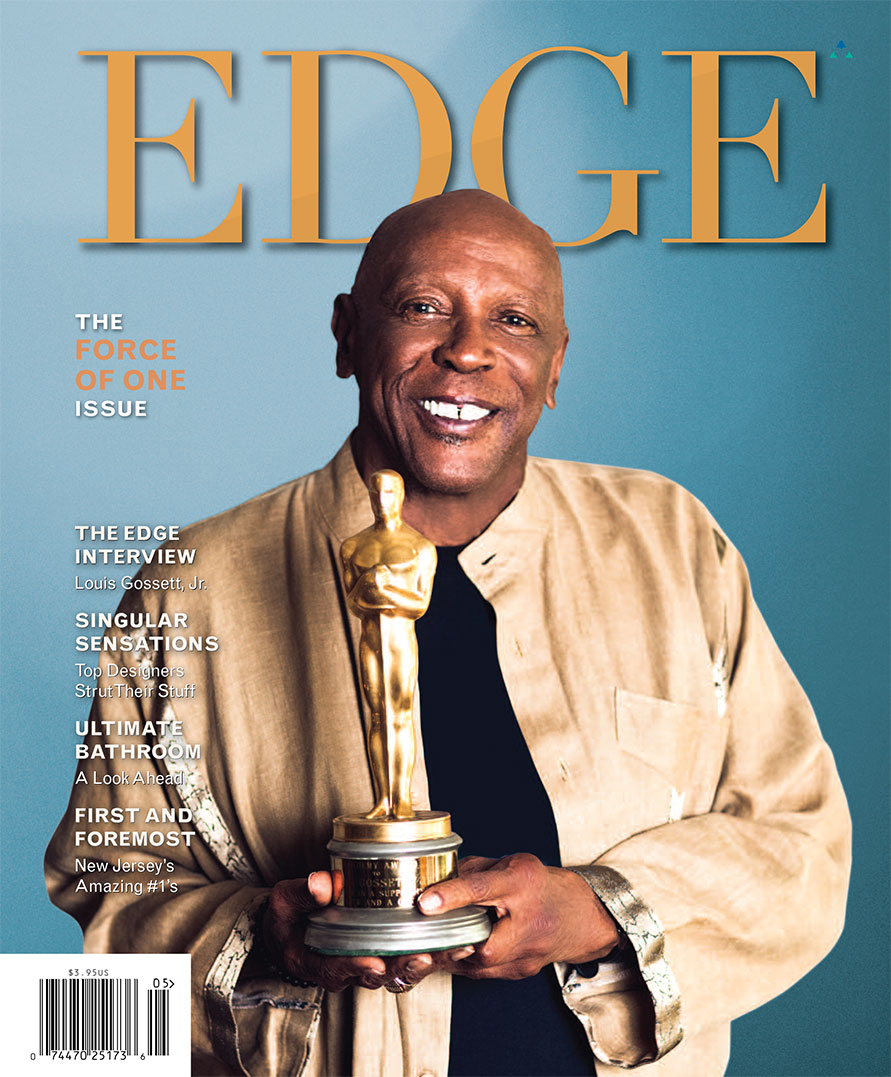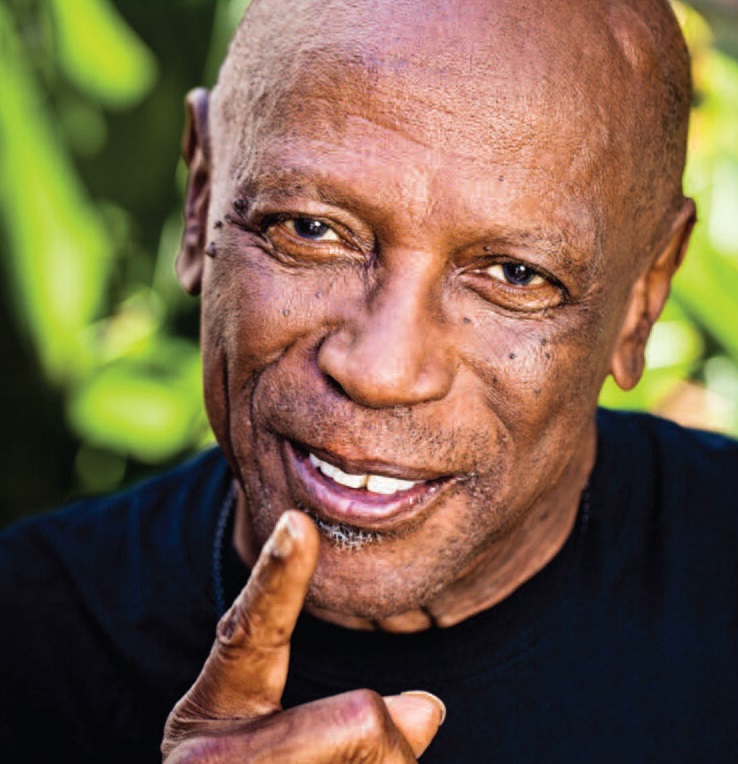 ED PROJECT ON SCHEDULE AND ON BUDGET
ED PROJECT ON SCHEDULE AND ON BUDGET
The Williamson Street campus is busy with active construction and renovation in and around our Emergency Department. We’re in the middle of an $18 million project that will almost double the depart-ment’s size and capacity, create a dedicated diagnostic imaging suite, and feature areas for pediatric, geriatric and behavioral health patients. The result will be a bigger, better emergency department and improved patient comfort, privacy, and satisfaction.
Construction is now complete on the imaging suite. Completion of the new ED waiting room and surgical sub-waiting room is expected very soon. Throughout April, ED operations will move from existing areas to these newly-built areas as Phase 1 reaches completion.
Phase 2 will be the construction of the ICU expansion, and creation of geriatric, behavioral health, and fast track/pediatric areas. By December, Phase 3 will begin on the cosmetic renovation to the existing ED. August 2017 is the projected date of completion.
Support of our donors has helped bring the vision of this major project to reality. Thanks to generous individuals, companies, foundations, and Trinitas physicians and staff, we are well past the halfway mark to our multi-million dollar goal.
Why not join our donor family in supporting our Emergency Department expansion and renovation that will help us continue to bring superior healthcare to our community. Please contact Nadine Brechner at nbrechner@trinitas.org or Rob Eccles at reccles@trinitas.org, or call the Trinitas Health Foundation directly at 908 994-8249.
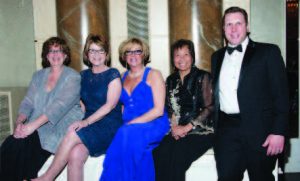 GATHER WITH US FOR OUR ANNUAL GALA!
GATHER WITH US FOR OUR ANNUAL GALA!
You can be part of a night to remember! Join enthusiastic supporters of Trinitas at the Trinitas Health Foundation’s 2016 Gala on Thursday, May 12. The theme of this year’s event Rising to the Challenge.
Mortimer Gershman, benefactor of the Health Foundation and long-time member of the Foundation Board, will be posthumously honored with the Foundation’s Celebrating Philanthropy Award. His wife, Jacqueline, will accept his award.
The excitement of the Gala returns for a fifth year to The Venetian in Garfield, New Jersey, where the breath-taking ambiance of the venue is rivaled only by the extraordinary food, drink and socializing. The Infernos Band, the area’s premier live performance group, will perform music throughout the evening. The dynamic group boasts Richie Rosato, former lead singer of The Duprees, and Kenny Simmons, former member of The Commodores.
During a full cocktail hour, guests can meet and mingle as they view a distinctive array of extremely desirable items up for bid at the Silent Auction including trips and one-of-a-kind experiences. Take your chance on a 50/50 raffle, another way you can contribute funds that will benefit Trinitas patients.
For information about attending the Gala or opportunities for sponsorship, contact Laura Ciraco at lciraco@trinitas.org or call 908 994-8249 or go to www.trinitasrmc.org/foundation.htm and click on the Gala invite.
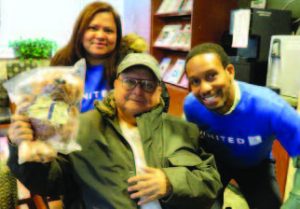 WINGS OVER TRINITAS
WINGS OVER TRINITAS
The United Adventure Bear program, a community outreach program of United Airlines, winged its way to Trinitas and the Trinitas Comprehensive Cancer Center to distribute the plush bears to Trinitas patients. Complete with their own Passports, the bears brought smiles to patients like Jose Velasco as United employees Estella Ventura and Christopher Bowers presented him with a bear that brightened his day. The Trinitas Health Foundation hosted the visit of United employees and shared information about Trinitas’ strengths as a community hospital boasting 10 Centers of Excellence.
 Schizophrenia Game-Changer?
Schizophrenia Game-Changer?
A team of researchers from Broad Institute, Harvard Medical School and Boston Children’s Hospital has identified a molecular process in the brain that helps to trigger schizophrenia. It may reveal what goes wrong in a young person diagnosed with the disease. “Research has identified several genes associated with schizophrenia,” says

Mona Ismail, MD
Medical Director Child Partial Hospital Program 908.994.7028
Mona S. Ismail, MD, Medical Director of Trinitas’s Child Partial Hospital Program. “But, until this study, we needed to know their mechanism of action that leads to the manifestation in young adults.” The landmark discovery, published in the February edition of Nature, could be a game-changer, given the emphasis on early detection and new treatments for schizophrenia. Dr. Steven Hyman of MIT, a former director of the National Institute of Mental Health (NIMH) says he is “almost giddy about these findings.” The process identified in the study shows that the risk of schizophrenia is dramatically increased if a young person has inherited variants of a gene important to synaptic pruning, the healthy reduction during adolescence of brain-cell connections that are no longer needed. What neurologists find especially exciting is that this discovery helps makes sense of a lot of other observations about the disease, which affects more than 25 million people around the world. “The question now is, ‘How can we use this information to alter this disease process?’” Dr. Ismail adds. “If we can interrupt it, then we might be looking at a possible cure rather than a lifetime of prescriptions for symptom management, at best. I think with the advancements of genetic and molecular science we are getting there.”
 The Health Benefits of Equal Pay
The Health Benefits of Equal Pay
Researchers across the river at Columbia University recently looked at data on 22,000 working adults between the ages of 30 and 65 hoping to understand why women are more likely to suffer from depression and anxiety than men. What they found was that women who make less than men with similar levels of education and experience were four times more likely to develop an anxiety disorder, and 2.5 times more likely to suffer from depression. Those gaps all but disappeared, however, among women who made the same or more money than their male counterparts. The gender wage gap—when added to the added responsibility for childcare and housework—produces feelings of inequality, unfairness and insecurity that seem to account for the prevalence of anxiety and depression. “Primary care physicians don’t typically discuss wages or income with patients,” says

Vasyl Pidkaminetskiy, MD Trinitas Physicians Practice 732.499.9160
Vasyl Pidkaminetskiy, MD, of Trinitas Physicians Practice in Rahway. “They may touch on general job and family stress, and focus on symptoms and family history as part of making a diagnosis of depression. Since this study points to inequality in pay as it contributes to the rates of depression among women, that is something we as primary care physicians should include in our conversations with patients in the future.”
 Screen Strain: It’s a Thing
Screen Strain: It’s a Thing
Multi-taskers be warned: The Vision Council released a report in January after surveying 10,000 people who spend a large portion of their day in front of a computer screen. The survey revealed that people who use multiple devices (e.g. tablet, e-reader, smart phone, smart watch) at the same time experience eye strain, and neck, back and shoulder pain more than users of one device. People in their 20s are most at risk, as they are the most likely to use multiple devices. More than 70 percent of the people in the survey reported these symptoms. Overall, about 60 percent of us use electronic devices for five or more hours a day. The good news is that digital eye strain is almost always a temporary problem. It is caused by the tiny muscles in the eye being overworked focusing on objects close to the face, or adjusting to differing levels of illumination.
 Small Wonder
Small Wonder
One of the major obstacles in treating lung disease has been getting medicine to tough-to-reach parts of the respiratory system. A joint project between Malaysian scientists and Harvard University School of Public Health researchers is seeking a safe and effective way to overcome this obstacle through the development of “smart” nanoparticles that are even smaller than the particles produced by the fine sprays and mists used by lung cancer and COPD patients today. Nanotechnology is the manipulation of matter at a molecular scale, up to 100 nanometers. A nanometer is one billionth of a meter.

Vipin Garg, MD
Director, Trinitas Comprehensive Sleep Disorders Center 908.994.8880
Dr. Vipin Garg, a board-certified physician in pulmonology at Trinitas, is intrigued by this idea. “Those of us who treat patients with obstructive airway diseases like COPD and asthma increasingly realize the important role that smaller airways play in these diseases,” he says. “Our experience shows that newer inhalers with particles reaching the smaller airways have improved management of these diseases.” Currently about 10 percent of deaths are caused by irreversible obstruction of the airway.
 What You Don’t Know Can Hurt You
What You Don’t Know Can Hurt You
Urinary Tract Infections (UTIs) account for more than 8 million doctor visits a year in the U.S., generating $1.6 billion in health costs. They are also the second-greatest reason why doctors prescribe antibiotics to women. Yet as two recent studies show, women know surprisingly little about UTIs. For example, only 13 percent of women 18 to 45 knew that sexual activity is a primary cause of bladder infection, and were unaware of the basic precautions that can prevent it. Thirty-nine percent of women assumed that UTIs go away if they do nothing. The fact is that if UTIs are left untreated they can lead to kidney infections, kidney stones or even kidney failure.
 Gene-Editing Breakthrough
Gene-Editing Breakthrough
A team of scientists at the University of Texas Southwestern Medical Center has used a new gene-editing technique to halt the progression of Duchenne muscular dystrophy in mice. Duchenne is a rare disorder caused by a mutation in the protein dystrophin. It results in muscle degeneration and premature death. The mutation is carried on the X chromosome. It can be carried by males and females, but strikes boys, usually around age 2 or 3. If the technique is successfully scaled up, it will be the first to eliminate the cause of the disease as opposed to just diminishing its effects. The UT team published its findings in Science.
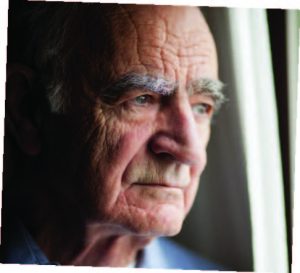 Mind & Body Connection
Mind & Body Connection
You learn something new every day. For centuries it had been widely accepted in medicine that the brain did not have a direct connection to the immune system. An NIH-funded study completed by University of Virginia researchers in 2015 proved otherwise, as malfunctions in these vessels were shown to contribute to certain neurological diseases, including Alzheimer’s and autism. Abnormal immune activity had been associated with psychiatric conditions in the past, but the UVA study showed evidence of direct links.
No matter the variables, treating patients like family is part of the Trinitas equation.
By Erik Slagle
When Martin Mintz went into cardiac arrest on September 30th, 2015, he was far from home and the hospitals he was familiar with. A 95-year-old resident of Brooklyn, Martin was visiting family in Elizabeth when the heart attack occurred. The responding paramedics administered the “Code Frosty” protocol—induced hypothermia that preserves brain function in patients following cardiac arrest—and rushed him to Trinitas. There, says his daughter Selena, he experienced a level of care and compassion that met or exceeded that of the most prestigious New York medical centers, making his stay in an unfamiliar hospital a little easier.
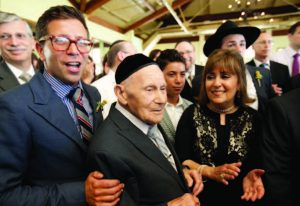 Martin, a Holocaust survivor, spent five years in a concentration camp in Poland. The Jewish faith is an indomitable trait of the Mintz family, and at a time of crisis they were able to find some solace in the hospital’s Bikur Cholim Room. Bikur Cholim is the Hebrew phrase for “visiting the sick,” and Martin’s family was impressed that Trinitas, a Catholic hospital, makes this accommodation available for Jewish families in need of support and a place to come together in prayer.
Martin, a Holocaust survivor, spent five years in a concentration camp in Poland. The Jewish faith is an indomitable trait of the Mintz family, and at a time of crisis they were able to find some solace in the hospital’s Bikur Cholim Room. Bikur Cholim is the Hebrew phrase for “visiting the sick,” and Martin’s family was impressed that Trinitas, a Catholic hospital, makes this accommodation available for Jewish families in need of support and a place to come together in prayer.
Beyond the spiritual support, Selena says the medical care her father received was equally outstanding. “The doctors were thorough, attentive and caring,” she says. “The nursing staff was very helpful and calm as they went about their work. They made sure all the patients were comfortable. One of the nurses even offered to work with my father on her day off because she was so concerned about him. Our family was so very impressed with the whole staff.”
Several of her father’s doctors, adds Selena, stand out for reasons that went beyond just their medical expertise. Dr. Maria Khazai of the Nephrology Department told her, “I’m taking care of him like that is my father in the bed.” Selena appreciated the candor of cardiovascular specialist Dr. Mehrewan Joshi in assessing Martin’s condition. Along with Drs. Arthur Millman, Clark Scherer, Ying Tao, and Michael Chen—and ICU Director Dr. Michael Brescia—they formed
a team of constant support. Selena also singles out Dr. Leon Pirak for the attention and assistance he provided during Martin’s care.
“Dr. Pirak was simply unbelievable,” she says. “He oversaw everything and ensured that our family always got answers to our questions, and were always fully aware of what was happening. We were able to discuss everything with him and make sure all aspects of my father’s care were being addressed. Everyone here is an advocate for family members—they constantly check to see how they are doing, if there’s anything they need, down to little details like a cup of coffee to pick someone up. Everyone we came into contact with at Trinitas was simply wonderful.”
Martin passed away later that autumn, but Selena says it was a comfort knowing he was so well cared for in his final days. The doctors, nurses and staff at Trinitas made every effort to give care—“beyond what we had seen when my father was admitted to other hospitals in Brooklyn and New York City.”
“My father was treated with great dignity and humanity,” she says. “We’re very grateful to Trinitas for the way he was tended to and the care he was given.”
Spring initiative highlights organ donation.
By Caleb MacLean
On any given day, more than 120,000 people in America are waiting for an organ transplant. On average, 22 people a day die for lack of a donated organ. There are currently more than 5,000 New Jerseyans on various transplant lists. How this precious material gets from donors to recipients is a mystery to most people. That is where groups like NJ Sharing Network come in.
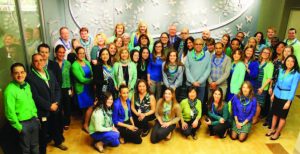 NJ Sharing Network is a non-profit, federally designated organ procurement organization. It was formed three decades ago at about the same time the government passed legislation that required hospitals to present the option of donation to families of potential donors. Since then, organ donation has quadrupled in New Jersey, saving, extending or restoring countless thousands of lives. NJ Sharing Network coordinates the efforts of hospitals, transplant centers, medical examiners and funeral directors, as well as increasing public awareness through education and media outreach. The organization will be particularly busy this April, during National Donate Life Month. Schools, community groups, businesses, elected officials and, of course, hospitals around the country will be demonstrating their support of organ and tissue donation, and encouraging people to start talking about what they would do if a family member becomes a candidate for donation.
NJ Sharing Network is a non-profit, federally designated organ procurement organization. It was formed three decades ago at about the same time the government passed legislation that required hospitals to present the option of donation to families of potential donors. Since then, organ donation has quadrupled in New Jersey, saving, extending or restoring countless thousands of lives. NJ Sharing Network coordinates the efforts of hospitals, transplant centers, medical examiners and funeral directors, as well as increasing public awareness through education and media outreach. The organization will be particularly busy this April, during National Donate Life Month. Schools, community groups, businesses, elected officials and, of course, hospitals around the country will be demonstrating their support of organ and tissue donation, and encouraging people to start talking about what they would do if a family member becomes a candidate for donation.
“Everyone needs to have the conversation with their family members about what they would do if they could give the gift of life,” says Jackie Lue Raia, Assistant Director of Resource Development for NJ Sharing Network. “The idea behind National Donate Life Month is to get the community talking about organ and tissue donation.”
In New Jersey, most people are exposed to the concept of donation through the Motor Vehicles donor registry; 34 percent say yes to donation on their driver’s licenses. However, at bedside, that number soars to more than 60 percent, which means there is room for immediate improvement. The need for greater participation is magnified by the fact that less than 1 percent of deaths can actually give the gift of life. A person must be in a hospital, on a ventilator—typically as the result of a stroke, heart attack, aneurysm or auto accident with a traumatic brain injury.
Last year, NJ Sharing Network facilitated 531 transplants. According to Lue Raia, that made it the “best year ever.”
NJ Sharing Network operates a fully accredited, state-of-the-art transplant lab, which performs compatibility testing between donors and recipients, and also pre- and post-transplant evaluations—a critical component in assuring the success of transplants for hard-to-treat individuals. The lab handles compatibility determination for a number of regional hospitals, including Trinitas. The organization also has a Family Services division for donor families.
According to Mary McTigue, RN, the VP of Patient Care Services at Trinitas, as well as Chief Nursing Officer, the professional relationship between the hospital and the Sharing Network is very strong. “Both staffs always work in close collaboration to ensure a caring and compassionate approach towards potential donors and their families,” she says. “The skill and expertise of the staff recognizes the sensitive needs of a potential donor family, as well as the drive for a successful outcome for the potential organ recipient.”
The engine that powers NJ Sharing Network is its robust corps of volunteers (above). They handle the outreach initiatives that educate the public about donation and transplantation by participating in events or civic groups, businesses, community centers and houses of worship.
“If the community is more open to talking and being proactive, we would be able to save more lives,” says Lue Raia. “Particularly in the area of tissue donation, which encompasses procedures including bone grafts, ACL and rotator cuff repairs and breast reconstruction. Volunteers can speak at pubic events, facilitate programs at worksites, or work at hospitals. Each is highly trained and vetted, with a thorough background check. Anywhere we send our ambassadors, you’re getting the best of the best.”
What do NJ Sharing Network volunteers have in common?Most have a personal connection to the organization. Jackie Lue Raia herself was a “donor daughter.” Six years ago, she was driving back from Newark Liberty Airport with her mother and son when a tractor-trailer slammed into their car on the New Jersey Turnpike. Her mother suffered fatal injuries in the crash. Her organs and tissues ended up going to 43 people. Two years later, Lue Raia decided to meet the two kidney recipients (right). One was the same age as she was, the other the same age as her mom. Soon after, she noticed a job opening at NJ Sharing Network. Needless to say, her experience with organ and tissue donation has proved invaluable.
 “In part because my mother had not made the decision to be an organ donor,” she explains. “We’d never had that conversation. The clock was running out and the siblings had to make a decision. That was my first encounter with NJ Sharing Network. A volunteer met with us and convinced us that this was something my mother would want to do.”
“In part because my mother had not made the decision to be an organ donor,” she explains. “We’d never had that conversation. The clock was running out and the siblings had to make a decision. That was my first encounter with NJ Sharing Network. A volunteer met with us and convinced us that this was something my mother would want to do.”
Editor’s Note: On June 5 in New Providence, NJ Sharing Network is sponsoring a USATF certified 5K race. For more information on this event call (908) 514–1761. For info on NJ Sharing Network itself, log onto njsharingnetwork.org or call (800) 742–7365. Promotional materials and kits for National Donate Life Month can be downloaded from the web site.
Tales from the front lines of New Jersey’s heroin epidemic.
By Mark Stewart
Welcome to Heroin Town. That eye-catching headline ran last December on the NJ.com web site. The story posited that, if one were to take all of New Jersey’s heroin addicts and put them in one place, the population would work out to about 128,000 people—making it the fourth-largest city in the state. The scope of the heroin problem in New Jersey has grown over the last decade, claiming 5,000 victims and ruining the lives of countless hundreds of thousands since the mid-2000s. The optics of heroin addiction have changed, as well. It’s now someone you know, someone you work with. Maybe it’s someone teaching your kids. Or maybe it is your kid.
Or, possibly, it’s you.

Michele Eichorn, Addiction Therapist
According to Michele Eichorn (left), an addiction therapist who runs the Hospitalwide Screening for Substance Use Disorders project for Trinitas Regional Medical Center, the Hollywood version of the zonked-out junkie in an abandoned building or trash-strewn alleyway is not what heroin addiction looks like anymore.
“The face of addiction has changed,” she says. “Now everybody knows someone with a heroin problem. Chances are, you have a neighbor or a friend or a co-worker or a family member with a drug addiction. It could be that sweet cheerleader who was a friend of your daughter’s 15 years ago. Now she’s hooked on painkillers, or worse. More than ever, this is a problem that’s in people’s backyards.”
Eichorn offers the example of a woman she calls Jane. Jane is a 40-something well-adjusted woman with a college degree, solid work history and a family. Jane was in a motor vehicle accident and had terrible pain. She was put on pain medication, which affected her performance at work. Eventually, she was laid off from her job, lost her insurance and could no longer afford the medication. So she started using heroin because it was the only thing she could afford that made the pain bearable.
“That’s actually a case that happened here and it was heartbreaking,” Eichorn says.

www.istockphoto.com
IT ALL BEGINS WITH PAIN
Heroin addiction stretches across the full socioeconomic spectrum. It’s a problem in the inner city, to be sure, but its impact is felt in small working-class towns and sprawling suburbs, too. Addiction doesn’t discriminate, it’s not particularly picky and it almost always begins with physical pain. A twist, a tear, a sprain, a strain. An operation. A work accident. A car accident. A prescription for 30 Oxycontin—enough to help manage the discomfort, enough to get a patient over the hump.
However, when the little orange container runs out and reality sets in, we really miss those pills. Some of us a lot more than others. How one deals with that need can alter the course of a life, a family, a career.
The first call is typically to the doctor to renew the prescription. Most physicians have become hyper-aware of the addiction risks, and also that they are at the fulcrum of a growing problem. A Los Angeles doctor was recently convicted of murder and sentenced to 30 years after three of her patients overdosed. No physician wants to swap a lab coat for an orange jumpsuit. So they prudently move patients to a less-addictive option. Alas, the warm, fuzzy high isn’t there and sometimes those patients look for pills in other places. On the street, of course, there’s no copay plan. Each pill costs $25 or more. For someone accustomed to gobbling a half-dozen a day, that works out to thousands a month. Some stick with that model until their bank accounts and 401k’s are drained. Or until the shut-off notices start piling up. Others sell their possesions, however and wherever they can. In the end, though, addiction usually boils down to a matter of dollars and cents: How can I achieve my next high for as little as possible? It’s all about today. Tomorrow matters less and less the deeper a person tumbles into addiction.
This is where heroin typically enters the picture. Oxycontin and other prescription opioids are basically pharmaceutical spins on heroin. Heroin may not be as neat or as clean or as “safe” as pills, but with heroin an addict can stay afloat all day for the same cost as a single street-purchased Oxy. And heroin is available everywhere. Take a look at your local police blotter and see where the arrests are taking place. In office buildings. At shopping malls. Outside convenience stores and fast-food joints. The places you already go every day.
A VORACIOUS ANIMAL
Sadly, people overdose and die from painkillers every day. It is a growing problem. Heroin, however, is an entirely different animal, and lately it’s been voracious. According to the Centers for Disease Control and Prevention, since 2010 overdose deaths among heroin users have tripled in the United States. About 1 in 50 addicts will die of an overdose. In New Jersey, the problem is far worse—at least three times worse, in fact. This year, heroin overdoses will kill more New Jerseyans than automobile accidents, homicide, suicide or AIDS. What that number will be—700, 800, 1,000, more—is anyone’s guess. But it will be a big number.

Michele Eichorn, Addiction Therapist
What is being done about this problem? First off, it’s not really a law enforcement issue. Heroin is so widely available in New Jersey that arresting dealers is like playing a carnival Whack-a-Mole game. Smash one down and another pops up immediately. Doctors have become more vigilant about over-prescribing and monitoring their patients’ use/abuse of painkillers, which certainly can stop a problem before it starts. However, there is some thought that closing down pill mills and, in general, being more judicious about refilling prescriptions simply drives more people underground for their drugs, and ultimately into the arms of a heroin dealer. Also, in terms of the overdose epidemic, the availability of the life-saving drug Naloxone may actually embolden heroin users, who regard it as a sort of get-out-of-jail-free card, often with deadly results.
So we are left to deal with addiction in emergency rooms, in rehabilitation facilities, in jails and in the morgue.
ON THE FRONT LINES
Trinitas has been a leader in the field of treating addiction, initially with its Substance Abuse Services Department and, beginning in 2014, with its Hospitalwide Screening for Substance Use Disorders project. Now every adult patient who is medically admitted to the hospital—regardless of how they present—sits down with a nurse and has a conversation about alcohol and drug use, during which an Alcohol Use Disorders Identification Test (AUDIT) is administered and scored on a scale of 1 to 10. Some of these patients arrive at Trinitas through the ER with drug- or alcohol-related injuries, while others come to the hospital for scheduled procedures, such as removal of a gall bladder or foot surgery. Regardless of what brings them to Trinitas, when patients score an 8, 9 or 10, Michele Eichorn’s team is called in.
“At that point, we do a brief intervention using a technique called motivational interviewing,” she explains. “We have an honest conversation with the patient and really listen. If the person is agreeable, we’ll refer them to treatment and come up with a plan quickly, usually within a matter of hours, or at most a couple of days. It’s a very short window. And in order to ensure that people really are getting to treatment, we have a team of people—an addiction specialist who encourages them, a case manager who conducts outreach and helps people get into programs, and a therapist who is available to work with the individuals.”
Eichorn, who holds a masters degree in Social Work from Columbia University, initially became interested in the field of substance abuse while serving in the Army. She worked with veterans’ drug and alcohol issues and later did an internship at the National Institute of Addiction and Substance Abuse. Eichorn’s research showed that substance abuse as a whole was growing. She saw a challenge and wanted to be on the front lines. When she first arrived at Trinitas, she ran a program for drug-addicted mothers and pregnant women.
During the two short years the Hospitalwide Screening for Substance Use Disorders project has been up and running, between seven and 14 patients a month have been plucked out of the patient population and placed into drug or alcohol treatment. In the years prior, less than two percent of the patients for whom Trinitas counselors recommended treatment actually went. The project has already established itself as a difference-maker, Eichorn believes.
50–50
On the drug-addiction front, perhaps the most eye-opening number to come out of the Trinitas project is the breakout of alcoholism referrals vs. drug referrals: “What we noticed immediately was that, among the patients our team saw, there was a 50-50 split between chronic alcoholism and serious drug addiction,” Eichorn says. “That includes heroin and other opioids, medications like Xanax, and so-called club drugs. A number of people fell into both groups.”
While the Hospitalwide Screening for Substance Use Disorders project can help heroin users get into the in-patient rehab programs they need, the lack of detox beds available can mean addicts may have to wait two months to start. That delay often has tragic consequences.
“The demand for treatment has increased so much that now folks are literally dying on the waiting list,” Eichorn confirms. “The problem we face is related to the availability of heroin. People are overdosing while they are waiting to get into programs. We know we may only have one shot to engage these people and get them into treatment.”
What stands out the most among the heroin users she sees?
“I’m a therapist so that’s what I can talk about,” Eichorn says. “What I will say is that many patients report that they have trauma in their background. And they have never been part of what we think of as ‘heroin culture’—communities where people are just hanging out and drugs are rampant. A lot of the individuals we see just don’t fit that profile at all. Something unfortunate happened and suddenly they are in this terrible, heartbreaking situation.” EDGE
Editor’s Note: The Hospitalwide Screening for Substance Use Disorders project is funded by Medicaid’s Delivery System Reform Incentive Payment (DSRIP) program. Michele Eichorn LCSW, LCADC was a recipient of the 2015 Lester Z. Lieberman Award for Humanism in Healthcare from the Healthcare Foundation of New Jersey. She says if she could change two things about the current substance-abuse landscape it would be to make therapy services more readily available to a larger percentage of people, and to reduce the stigma attached to seeking help for substance abuse. “Rather than dealing with people in desperate situations, we could be dealing with them much earlier.”
A look ahead.
By Christine Gibbs
Over a lifetime, the average person will probably spend close to 20,000 hours in the bathroom. If you bother doing the math it comes out to almost an hour a day. When weighed against the time spent, say, in bed, it pales in comparison. However, what you do in the bathroom you couldn’t (or hopefully wouldn’t) do anywhere else. Which is why the bathroom gets a lot of attention but not always a lot of respect. In recent years—thanks largely to home buying and home improvement “reality” shows—Americans have started looking at their bathrooms with a more critical and creative eye…and wondering what the future might bring to that most intimate room in the house
First a little history. Humankind has made commendable progress when it comes to taking care of our business.

Black Book Archives
Though some would say we still regard the world as our toilet, the truth is that people have been thinking and rethinking the john for thousands of years. Historians have traced commodes to the Indus Valley civilization some 5,000 years ago, while some experts believe primitive toilets date back 7,000 years earlier than that. Leave it to the ever ingenious and pragmatic Romans to install the first pay toilets in Rome, in 74 AD. The first flush toilet was a royal one, installed for Queen Elizabeth I by Sir John (the original “john”) Harrington, in 1596. And, yes, the modern toilet really was designed by Thomas Crapper (left), in the late 19th century
In the 21st century, the trend has been toward transforming the bathroom from a traditionally functional space into an opulent retreat that more closely resembles a high-end spa than a place for personal hygiene. Indeed, the bathroom label itself may be going the way of quaint terms like powder room, water closet and loo. Today’s bathroom is morphing into a sort of sanctuary that could conceivably rival the kitchen as the most expensive room in the house. Above and beyond the soaring cost of fixtures and finishes, bathrooms today overflow with gym-quality treadmills, touch-screen televisions, surround sound equipment, and other high-tech digital paraphernalia.

www.istockphoto.com
The Cost of Fine Bathing
Whether designing a new bathroom or renovating an old standard, cost is always a bottom-line factor, and the typical bathroom project is never cheap. Why? Five-figure invoices often are a result of the fact that renovating or adding a bathroom involves plumbing, electrical and tile work that needs to be done by talented and experienced professionals. The guy who shows up on a Saturday afternoon to unclog your drain is not necessarily someone you want to trust with a more elaborate project. Furthermore, today’s new bathroom will have more equipment, more appliances, and more leisure-time gadgets per square foot than any other room in the house. An ambitious “reno” or a new build can eat up as much as 10% of a home’s estimated value, especially if you do not budget wisely

www.istockphoto.com
Is it worth the time, money and trouble? US News & World Report actually ran a story a year ago that estimated the return on investment for a gold-standard bathroom. First of all, that should tell you something about who can afford such a project. Second of all, the numbers are good but not great: sellers can expect, on average, to recoup about 70% of their investment upon resale. That’s more than 2 percent higher than the average kitchen remodel. Of course, most experts agree that a high-end kitchen and master bedroom with master bath is almost guaranteed to sell a house faster and at a better price (in some markets, the ROI can be as much as 90 to 100 percent), so it’s not an either/or decision. And updating one bathroom may not be enough.
“Homeowners are seeking a balance among all the bathrooms in the house,” says Elisabeth Woomer, Showroom Manager at General Plumbing Supply in Green Brook, NJ. “Everyone looks to economize, whether it’s a renovation or a new build—economizing more on the family bathroom down the hall, while splurging on the private en suite master bathroom
Costs are often dependent on geographical location and can range from as little as $12,000 to $15,000 in hard costs for a standard hall bathroom (not to include labor) to as much as $50, 000 to $80,000 for an all-out luxury master bath, she adds. “We find out what the client is passionate about and then lead them to the best options that satisfy their passions…without breaking their budgets.”
Although New Jersey tends to be a more expensive state in terms of labor and materials, those numbers are right in line with national averages. The National Kitchen and Bath Association annually publishes its Bathroom Planning Guidelines, developed by a committee of experts who analyze statistics, lifestyles, trends and building codes to present recommendations that “promote the health, safety, and welfare of consumers.” In a recent NKBA survey, 50 percent of responding members confirmed the cost for a bathroom ranged between $10,000 and $29,000, while 31 percent said their average price was higher than $30,000

www.istockphoto.com
To Remodel or Not to Remodel…
That is the question. Given the considerable cost of turning an old bathroom into a modern miracle, when should you finally decide to take the proverbial plunge? First, take a look in the mirror. Is it part of a creaky medicine cabinet over a pedestal sink? Now look down. Is that dingy linoleum or, worse, pastel tile that matches the toilet and sink? You may be able to kid yourself into thinking your bathroom is hip and retro, but you won’t be kidding anyone else. It’s old.
The mistake some homeowners make at this point is to embrace a bathroom trend that’s already on the way out. A little homework is required here and, needless to say, opinions differ from expert to expert. But a quick look at interior design magazines and web sites can give you a sense of what’s in and what’s out. The Coastal Cottage motif? Out. Clean and contemporary with a touch of traditional is in. Bowl-shaped sinks sitting in the vanity? Out. Under-mounted sinks in leggy cabinets are in. Granite tops?Out. Quartz is the current choice for baths (as well as kitchens). Clean, white tile? Boring. Out. Daring, moody designs are in. That being said, with the current emphasis on clean lines, geometric shapes, and minimalist color schemes, a few small touches can make a big statement:
- Skip the “pop” of color and limit even accessories like bath towels to white or gray tones.
- Spring for a freestanding tub that you can strategically place within the bathroom to take full advantage of Feng Shui principles.
- If space is at a premium, consider placing the tub inside a walk-in, no-threshold shower.
- Showcase quartz and wood elements (yes, there are waterproof wood tubs).
- Connect with the great outdoors by bringing in potted plants from your garden and adding a skylight, budget permitting.
- Create an atmosphere with your lighting—it’s as important as the actual light fixtures you select.
- Emphasize that geometric feel by hanging framed prints and personal photos.
 Gadget Inspector
Gadget Inspector
With the decision to re-do a bathroom comes a dizzying array of technology options. Brooklyn-based Watermark manufactures a Luxury Shower System ($7,000) complete with a full-color digital touchscreen tablet that lets you select from among nine different shower “scenarios” that program water temperature, pressure, volume, lighting and timing. Kohler makes a $299 shower head with an embedded wireless speaker that delivers music, news and sports. For$750 more, you can purchase Kohler’s Underscore VibrAcoustic Bath, which turns your tub into a Bluetooth-enabled system in which music vibrates through the water when the tub is full and fills the entire bathroom with sound when empty. If you’re into New Age chromotherapy, Tubz Hydrotherapy makes a product that turns bathwater into an array of colors that elevates ordinary bathing to holistic ritual. Light also plays a part in Graff’s Ametis faucet (below), which features an LED display that ranges from blue to red, indicating the temperature of the flowing water ($3,528). Hansa’s Canyon faucet ($1,490) works much the same way over the basin. The Airblade tap, from Dyson ($1,800), doubles as a hand dryer.
 And it doesn’t stop there. Showers are now programmable. The RainBrain by Hansgrohe ($4,750) (right) takes total shower jet control to a whole new level, creating the equivalent of a stand-up body massage. How about a laser razor? Skarp makes a slick, minimalistic shaver that emits a powerful light to cut off your facial bristles. Its recent launch on Indiegogo (a crowdfunder for startups), raised almost $500,000 and is targeted to be available this year at $289. FitBit devotees will enjoy the Aria scale, which can be synched to a smartphone to record not only poundage, but also body fat percentage, body mass index (BMI), heart rate, and even let you know about the day’s weather forecast
And it doesn’t stop there. Showers are now programmable. The RainBrain by Hansgrohe ($4,750) (right) takes total shower jet control to a whole new level, creating the equivalent of a stand-up body massage. How about a laser razor? Skarp makes a slick, minimalistic shaver that emits a powerful light to cut off your facial bristles. Its recent launch on Indiegogo (a crowdfunder for startups), raised almost $500,000 and is targeted to be available this year at $289. FitBit devotees will enjoy the Aria scale, which can be synched to a smartphone to record not only poundage, but also body fat percentage, body mass index (BMI), heart rate, and even let you know about the day’s weather forecast
And then there is the centerpiece that no one likes to talk about: the toilet. I’m not sure how this is calculated, but the average person supposedly spends about five years on (or in front of?) the throne over a lifetime. Not surprisingly, just about every major plumbing manufacturer is rethinking, redesigning, and reengineering it. The Kohler Numi (left) is a case in point. It does just about everything except attend to your most personal hygiene. Its seat senses your approach and raises and closes all by itself. It contains heating elements to warm delicate derrieres and doubles as a self-adjusting bidet with vented airflow. Upgrades include Power-Save mode for energy efficiency and emergency flush for power outages. And if that’s not enough to justify the $6,338 price tag, then there is Numi’s tastefully illuminated panels, its powerful yet pleasant deodorizer, its touch-screen remote, and its wireless speakers
I n addition to the various technological bells and whistles they offer, manufacturers are also looking at the safety component of bathroom design. One of Jay Leno’s tried-and-true jokes is about how more people die each year in bathroom falls than in plane crashes (the punch line is, “Yeah, but when you fall off the toilet you’re not falling 30,000 feet!”). Still, it’s no laughing matter. According to the Centers for Disease Control and Prevention, nearly a quarter-million people over age 15 visit the ER annually as a result of a bathroom injury; 14 percent require hospitalization. Two-thirds of bathroom injuries are sustained in or near a bathtub or shower. The injury rate for women is 72 percent higher than for men. And, interestingly, you’re more than four times likelier to get hurt getting out of a tub or shower than getting in. Even if you’re not springing for the big bathroom reno, its worth doing a quick safety assessment. Look for poorly fitting shower curtains, slick tile floors, soapy tub or shower beds, antiquated or improperly installed glass shower doors, area rugs without non-slip backing, and space heaters. These are items worth an immediate upgrade.
n addition to the various technological bells and whistles they offer, manufacturers are also looking at the safety component of bathroom design. One of Jay Leno’s tried-and-true jokes is about how more people die each year in bathroom falls than in plane crashes (the punch line is, “Yeah, but when you fall off the toilet you’re not falling 30,000 feet!”). Still, it’s no laughing matter. According to the Centers for Disease Control and Prevention, nearly a quarter-million people over age 15 visit the ER annually as a result of a bathroom injury; 14 percent require hospitalization. Two-thirds of bathroom injuries are sustained in or near a bathtub or shower. The injury rate for women is 72 percent higher than for men. And, interestingly, you’re more than four times likelier to get hurt getting out of a tub or shower than getting in. Even if you’re not springing for the big bathroom reno, its worth doing a quick safety assessment. Look for poorly fitting shower curtains, slick tile floors, soapy tub or shower beds, antiquated or improperly installed glass shower doors, area rugs without non-slip backing, and space heaters. These are items worth an immediate upgrade.
Finally, there is the issue of ecological soundness. Most people undertaking a bathroom renovation opt for products and technologies that are environmentally friendly. There’s even a word for it now: Greenovating. The focus is on saving water, using fewer paper products, and avoiding dangerous cleaning agents. There are actually a lot of ways to “green up” our bathrooms. From Moen, we have a shortlist of ideas that don’t require much time or money:
- Install Low-flow Toilets and Showers
Toilets use on average 27 percent of household water consumption; older toilets can use up to about 7 gallons of water per flush. Older model showerhead will use 5 to 8 gallons of water per minute, while a low-flow head can reduce that to 2.5 gallons or less without compromising water pressure.
- Motion-Sensing Faucets
A mind-boggling amount of water is wasted by leaving the faucet running when washing hands or brushing teeth. A faucet with a built-in motion sensor remembers to shut off running water when you don’t.
- Change Light Bulbs
An LED bulb consumes 80 percent less energy and lasts 25 percent longer. That can translate into a cost savings of $160 per bulb on your electricity bill over its lifetime.
- Upgrade Bathroom Fans/Vents
Replace that old bathroom fan with one that is Energy Star-rated; it can provide up to 60 percent in energy savings.
- Shop for Eco-friendly and Sustainable Products Look for the Certified Organic label on everything from bath towels to toilet paper. Any increased cost is more than offset by a lower environmental footprint.
Open or Closed?
Among the many decisions that must be made in advance of a major bathroom renovation, the one that catches many people by surprise is whether the new loo’s design will lean toward privacy or open space. More and more, the line between the master bedroom and master bath is becoming blurred. Did you ever think someone would ask you whether or not you wanted a door on your bathroom? It’s a personal choice, to be sure, and doorless bathrooms don’t yet qualify as a widespread trend. But don’t be surprised if you start seeing homebuyers on one of those reality shows saying, “We love the bathroom, but the door’s gotta go.”
Whether open or closed, large or small, his, hers or available to the entire family, one thing about the bathroom will never change: It is essential to daily living.
In fact, all this talk of bathrooms has only made me yearn to retire to my own (rather retro) retreat. There I’ll draw a tepid, non-jet-propelled bath and I will relish the downtime despite the fact that there will be no lights and no music. There is nothing masterful about my bathroom, its shortcomings now only too apparent. But one of these days…
TRENDS FOR 2016
According to a National Kitchen and Bath Association (NKBA) study, these are some of the top bathroom trends for 2016:
- Neutral Color Palette
Earth tones rule the day, with off-white and beige not far behind.
- Undermount and Trough Sinks
The undermount style continues to be the most popular selection by a wide margin, but the trough type is gaining ground.
- Free-standing Tubs
Selected as a key trend by 67 percent of NKBA members in 2015 and predicted to increase this year.
- Shower Accessories
Special lighting, convenient seating and hand-held showerheads top the list.
- Polished Chrome Finishes
Selected by 80 percent of NKBA members as the most popular finish in 2015. Satin finishes in gunmetal and brass are growing in popularity.
- Pampering Luxuries
Radiant floor heating, steam showers, smart toilets, and even coffee and wet bars were cited as trends by 25 percent of NKBA members.
- Aging in Place Amenities
Seniors are focusing on age-friendly safety and other conveniences, including comfort-height toilets and no-threshold showers, in addition to traditional grab bars, taller vanities and lever door handles for easy opening by arthritic hands.
 A LITTLE BUDGET CONSCIOUS
A LITTLE BUDGET CONSCIOUS
A year ago, the Huffington Post addressed the issue of how to put your money to best use when renovating a small bathroom.
With $500…
- Apply a new coat of paint, preferably in a soothing, neutral earth tone.
- Take down fluorescent or incandescent lights and put up energy-saving LED bulbs.
- Buy some fresh, inexpensive accessories such as towels, plants, and prints.
- Expand storage by installing shelving and hanging racks.
- Rip up that germy old flooring and replace it with light and bright economical new tile.
- Consider investing $20 in a Glow Bowl, the motion-activated mechanism that transforms any toilet into a dazzling nightlight.
With $5,000…
- Reach out to professionals for help in upgrading plumbing and wiring.
- Optimize space by relocating or buying new fixtures that make you feel like you’ve moved into the 21st century.
- Invest in top-drawer ceramic or stone tile, and pay someone who knows what they’re doing to install it.
- Leave enough to get your bathroom repainted.
“The ricotta gnocchi, lavished with black truffles and nibs of wild boar sopressata, was so sensational I did something I’ve rarely done when dining out on the job.”
By Andy Clurfeld
The Frog and The Peach
29 Dennis St., New Brunswick. Phone: (908) 846.3216
Reservations and all major credit cards accepted. Open for dinner seven nights a week and for lunch Monday through Friday. Prices: Soups and salads: $9 to $14. Appetizers:$16 to $19. Entrees: $21 to $43. Sides: $9. Desserts: $12 to $14.
In the beginning, there was The Frog and The Peach…I wrote that sentence in my mind more than 25 years ago, when I started reviewing restaurants in New Jersey and concocting a sociogram of sorts that linked anyone and anything culinarily worthy in the Garden State. The Frog and The Peach was nerve central, chair of the brain trust, the heart that pumped inspiration and example to everyone else who served forth to the public. The Frog, born in 1983 on a bleak side street in New Brunswick and named for a Dudley Moore-Peter Cook comedy sketch, is where trends and some of the most respected, accomplished culinary and hospitality professionals in the state got their start. Industrial chic? Marquee status to local ingredients? Eclectic, boutique, artisan wine list? Fine-dining at a perfect-pitch bar? Check off a list that goes on and on: It all comes back to The Frog.

FrogAndPeach.com
The Frog today is owned by executive chef Bruce Lefebvre, who purchased the restaurant in 2012 from its birth parents, Betsy Alger and Jim Black. (Rutgers grads, of course.) The married couple had transformed the circa-1876 building at 29 Dennis St. that once housed the printing presses for New Brunswick’s newspaper, The Home News, into a multi-level theater for dining, where various stages could be set nightly for a variety of experiences. Tete-a-tete in an alcove? Communal dinner featuring cult wines in a set-off space? New and novel bites at the bar? Alger and Black’s revolution of continual evolution at The Frog also ignited their neighborhood: Once desolate and stark, with but one other restaurant and a synagogue nearby, the Hiram Square community is now desirable and swank, with brick townhouses that look plucked from Philly’s Old City and luxury condos that house Johnson & Johnson execs.

FrogAndPeach.com
The Frog as design guru/community activist/social conscience, however, is another story.
Lefebvre (facing page), schooled at Wake Forest, the Culinary Institute of America, post-college Frog kitchen and stints at New York City landmarks Aureole, Daniel and Lespinasse, is tag-teamed by general manager/wine director Jim Mullen, an alum of Georgetown, the Corcoran School of Art and restaurants such as the ground-breaking New York wine-and-food mecca Montrachet. There are well-informed front-of-the-house folks no matter where you step and a kitchen crew that seems eternally tuned to Betsy Alger’s famously exacting orchestrations. That’s the way of The Frog, back to the David Drake days, the Stanley Novack era and the Eric Hambrecht reign. Every one of these acclaimed chefs did time as top dog at The Frog.
The current menu under Lefebvre hits on all cylinders. It’s neither silly-obscure nor fearful of challenging diners who come here expecting to learn. There’s Le Quebecois veal tartare, given the sultry counterpoint of winter truffles more potent than the norm and pickled mustard seeds, a one-two punch of earth and warmth that cuts the richness of the veal and encourages a dab at the quail egg and a roll in the lardo. What could be too much luxury, particularly in a starter, is calibrated carefully—an exercise in control.

FrogAndPeach.com
Littleneck clams are partnered with a classic companion, pork sausage. But it’s the infusion of fresh ginger that elevates the dish, intensifying the flavors of both meats with a penetrating heat. Romanesco cauliflower, oh-so hip these days, is romanced by a fancy-schmancy duck Bolognese and a duck egg, then scattered with breadcrumbs. Intriguing, though its texture was off: I wanted to taste something crunchy or crisp to balance the plushness of the double ducks. Loved the concept of the octopus, billed as charred and Portuguese, even though it was served with a world of accents—enoki mushrooms, a chili-miso sauce, treviso, eggplant—but found the execution problematic: The chunks of octopus were alternately tough or mushy and the chili-miso sauce oddly without spirit.

FrogAndPeach.com
But the ricotta gnocchi, lavished with black truffles and nibs of wild boar sopressata, was so sensational I did something I’ve rarely done when dining out on the job: I hailed a server and asked for another round. I had to taste more—immediately—of those near-weightless mini dumplings I once believed had reached their apex at the restaurant Vetri in Philadelphia, but have a new master hand in Lefebvre. Strewn amid the gnocchi are strands of mildly bitter greens, sweet roasted garlic and squash, deftly inserted accents that, again, serve to balance more forceful ingredients.
Opah, a warm-blooded fish that ranges from pale pink to rosy red when served raw but turns ghostly white when pan-seared as it was here, was brightened by two strong plate partners: a walnut paste much like the Georgian condiment satsivi, which brought a butteriness to the dish, and an olive-spiked brown butter that added a smoky salinity. Pompano took on a world of accents—taro, an avocado-coconut mash, sticky rice and kale soaked in chilies—and might have been more successful streamlined. Duck is done as a duo here these days, Long Island breast and quarter-size meatballs parked on the same plate with pretty cold-weather vegetables: pearl onions, squash and Brussels sprouts. The unifying component here is the duck jus, lush as it is with truffles and parmesan. That’s one delish sipper. Another twosome spotlights Iberico pork,

FrogAndPeach.com
cured ham from Spain and Portugal. The Frog’s Iberico indulgence is splendid, what with a silky-textured skirt steak sliced from the pig and soulful nutty-herby croqueta made from braised rib meat. Maitake mushrooms, an aioli laced with sherry vinegar and blooms of nasturtium complete the plate.

FrogAndPeach.com
There’s lots of rum firing the flavor of the praline cake, which has an every-day-is-Mardi-Gras appeal. I was thinking the lemon-scented goat cheese tart needed a kick of another stripe to rev up its engine. But a confection that sounded ordinary—milk chocolate ganache isn’t exactly on trend these days—held my attention through the last fine bite.

FrogAndPeach.com
We don’t seem to want to leave The Frog and The Peach on this night; it’s late and there’s been a huge “Beer vs. Wine” dinner party in the garden room that I wish I’d had the courage to crash, the staff is quietly, discreetly re-setting tables for the next day. We should go home. But we linger. We’re in the bosom of the mother culture of restaurants in New Jersey, and it just feels good.
EDGE takes you inside the area’s most creative kitchens.
 Paragon Tap & Table • Bacon Wrapped Pork
Paragon Tap & Table • Bacon Wrapped Pork
77 Central Ave. • CLARK
(732) 931-1776 • paragonnj.com
I like to take traditional items such as pork and ravioli and create dishes such as Bacon Wrapped Pork tenderloin with Wild Mushrooms. Pair it with an award-winning craft beer or craft cocktail and see why were recognized by NJ.com as one of the region’s hottest restaurants.
— Eric B. LeVine, Chef/Partner
 BoulevardFive72 • Seared Day Boat Scallop
BoulevardFive72 • Seared Day Boat Scallop
572 Boulevard • KENILWORTH
(908) 709-1200 • boulevardfive72.com
Seared Day Boat Scallop, served with a Green Lentil Daube, Applewood Smoked Bacon Lardons, and Herbed Caper Butter. This has been a signature dish at Boulevard Five72 since we first opened. Over the years, our Scallops has been one of my most satisfying items to prepare.
— Scott Snyder, Chef/Owner
 Arirang Hibachi Steakhouse • Wasabi Crusted Filet Mignon
Arirang Hibachi Steakhouse • Wasabi Crusted Filet Mignon
1230 Route 22 West • MOUNTAINSIDE
(908) 518-9733 • partyonthegrill.com
We prepare a crusted 8-ounce filet mignon served with gingered spinach, shitake mushrooms, and a tempura onion ring.
 Daimatsu • Crab Avocado Salad
Daimatsu • Crab Avocado Salad
860 Mountain Ave. • MOUNTAINSIDE
(908) 233-7888 • daimatsusushibar.com
One of my favorite creations—I prepare something different every week—Crab Avocado Salad features snow crab, chipotle jelly, avocado, cilantro, lime soy dressing with yuzu citrus foam and caviar on top.
— Momo, Chef
 Publick House • Pan Roasted Salmon
Publick House • Pan Roasted Salmon
899 Mountain Ave. • MOUNTAINSIDE
(908) 233-2355 • publickhousenj.com
Our pan roasted salmon is one of our best selling entrees. Seared to give it a beautiful crispy skin, it is paired with roasted fingerlings, rock shrimp, chopped red peppers, cream, and saffron. The juxtaposition of textures and flavors really makes for an unforgettable dish.
— Bernie Goncalves, Owner
 Luciano’s Ristorante & Lounge • Warm Goat Cheese Salad
Luciano’s Ristorante & Lounge • Warm Goat Cheese Salad
1579 Main Street • RAHWAY
(732) 815-1200 • lucianosristorante.com
The warm goat cheese salad with tender greens and a mulled cabernet dressing and toasted pine nuts is a signature appetizer at Luciano’s, where fresh ingredients and personable service in a beautiful Tuscan décor create a fine dining experience. Our menus are seasonally influenced to feature the best of what’s available in the market.
— Joseph Mastrella, Executive Chef/Partner
 Morris Tap & Grill • Herb Chicken with fresh Gnocchi
Morris Tap & Grill • Herb Chicken with fresh Gnocchi
500 Route 10 West • RANDOLPH
(973) 891-1776 • morristapandgrill.com
Herb chicken with fresh gnocchi and house sausage finished with red wine garlic demi. This dish is a perfect example of how my team and I create fun and stylish food, and why we have received accolades for the last 4 ½ years from every major New Jersey dot-com and magazine.
— Eric B LeVine, Chef/Partner
 Boulevard Seafood Company • Sautéed Black Sea Bass
Boulevard Seafood Company • Sautéed Black Sea Bass
49 West Main Street • SOMERVILLE
(908) 722-0600 • boulevardseafoodcompany.com
Our Sautéed Black Sea Bass sits atop asparagus, finished with a black olive & caper vinaigrette. This is one example of the simple preparations we use that let the quality of our locally sourced seafood shine.
— Scott Snyder, Chef/Owner
 Spirit: Social Eatery and Bar • Jersey Breakfast Bar Pie
Spirit: Social Eatery and Bar • Jersey Breakfast Bar Pie
250 Morris Ave. • SPRINGFIELD
(973) 258-1600 • mclynns.com
Get in the Spirit! Our Jersey Breakfast Bar Pie features potatoes, Taylor ham, cheddar cheese and onions. It doesn’t get more Jersey than that!
— Mark Houlker, Chef
 Arirang Hibachi Steakhouse • Volcano Roll
Arirang Hibachi Steakhouse • Volcano Roll
23A Nelson Avenue • STATEN ISLAND, NY
(718) 966-9600 • partyonthegrill.com
Hot-out-of-the-oven, crab, avocado and cream cheese rolled up and topped with a mild spicy scallop salad.
 Galloping Hill Caterers
Galloping Hill Caterers
Galloping Hill Road and Chestnut Street • UNION
(908) 686-2683 • gallopinghillcaterers.com
Galloping Hill Caterers has been an incredible landmark for nearly sixty years. We pride ourselves in delivering “over the top” cuisine, impeccable service and outstanding attention to detail. That is the hallmark of our success! Simply, an unforgettable experience. Pictured here is one of our crepes flambé that really creates lots of excitement!
— George Thomas, Owner
 The Garden Restaurant • Top Sirloin Baseball Cut Steak
The Garden Restaurant • Top Sirloin Baseball Cut Steak
943 Magie Avenue • UNION
(908) 558-0101 • gardenrestaurantnj.com
The Garden’s top sirloin baseball cut steak is deliciously prepared to set off every flavor on the palette. Accompanied by our “sweeter than lobster” Nigerian jumbo tiger prawns, this butcher’s choice certified angus is served on our chef’s finest steak board to display the flavor infusion accentuated with house made sweet peppercorn sauce. Served with a simple accompaniment of seasonal roasted vegetables and garlic mashed potatoes.
— Justin Massie, Executive Chef
You heard it here first.
By Mark Stewart
New Jersey is a land of famous firsts. According to the state.nj.us web site, we have played host to the first light bulb, first steam locomotive, first phonograph, first submarine, first drive-in movie, first electric guitar, and first football game. There are many more, of course. And yet, in this litany of #1’s, there is one fantastic first that is nowhere to be found in school textbooks or anywhere in our popular culture. On April 25th, 1893, during a ceremony atop the Navesink Highlands overlooking Sandy Hook, the Pledge of Allegiance was given as the national oath of loyalty for the first time.
How this day came together is a tale of passion, politics and power. How it ended up in the dustbin of history is a reminder of how fragile our cultural heritage can be.
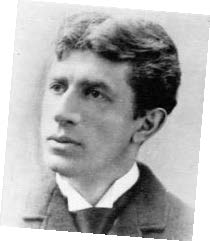 The Pledge of Allegiance looked a little different back then. It read: I pledge allegiance to my Flag and the Republic for which it stands, one nation indivisible, with liberty and justice for all. Subsequent wording referencing the “United States of America” and “Under God” was added in the 1920s and 1950s, respectively. The original version was written in 1892 by Francis Bellamy (right) and published in The Youth’s Companion as part of a school program to celebrate the 400th anniversary of the arrival of Christopher Columbus in the Americas
The Pledge of Allegiance looked a little different back then. It read: I pledge allegiance to my Flag and the Republic for which it stands, one nation indivisible, with liberty and justice for all. Subsequent wording referencing the “United States of America” and “Under God” was added in the 1920s and 1950s, respectively. The original version was written in 1892 by Francis Bellamy (right) and published in The Youth’s Companion as part of a school program to celebrate the 400th anniversary of the arrival of Christopher Columbus in the Americas

All images courtesy of Upper Case Editorial Services
The Columbus Day ceremony was held on October 21. A mere seven months later—blinding speed by 1890s standards—Bellamy himself led a group of young men in reciting the Pledge during an event in New Jersey that might draw millions were it recreated today. It involved an unprecedented international naval review (above), followed by parades and parties in New York City that went on for days. The next time anything like it was even attempted was during the Bicentennial, in 1976, when the tall ships arrived
 JERSEY BOY
JERSEY BOY
The key player of this story was not Bellamy, but William McDowell (right), a Newark-based financier whose business occasionally took him across the Atlantic. Upon each return to the U.S., McDowell marveled at the excitement that spread throughout the passengers as the first piece of American soil appeared. For the immigrants who filled steerage class, this moment was particularly meaningful. It marked the start of a new life. Roughly a third of Americans can trace some ancestry back to one of the people on these vessels. On a clear day, that first glimpse of America was the majestic Navesink Light Station, now known as the Twin Lights. Wouldn’t it be something, McDowell thought, if—before the two brownstone towers came into view—a gigantic American flag rose dramatically above the horizon? McDowell may not have been the first person to think of such a thing. However, he knew how to make things happen. His “Liberty Pole” plan first needed to gain the approval of the U.S. Lighthouse Board in Washington. The board was not known for its rapid decision-making. Fortunately, McDowell had friends in high places.
 An ardent patriot, he was among a group of patriotic Americans who hoped to rekindle America’s national spirit, which had been profoundly fractured since the Civil War. In 1889, McDowell founded the National Society of the Sons of the American Revolution, or SAR for short. Its aim was to recognize and celebrate American ideals and culture. The group enjoyed rapid acceptance and growth, counting among its early membership several wealthy and influential business and political leaders. In the summer of 1890, SAR officers decided to take the “Sons” part of the organization’s name literally and denied membership to women. McDowell was appalled. His great-grandmother, Hannah Arnett, was a popular heroine of the American Revolution. In 1776, a group of men meeting in her Elizabeth home were preparing to take the oath of loyalty to Great Britain in order to protect their lives and property. Arnett overheard them and called them traitors to their faces. Mr. Arnett’s attempt to remove his wife backfired; she threatened to divorce him on the spot. Eventually she convinced the group to reject the oath. An editorial by Mary Smith Lockwood published in The
An ardent patriot, he was among a group of patriotic Americans who hoped to rekindle America’s national spirit, which had been profoundly fractured since the Civil War. In 1889, McDowell founded the National Society of the Sons of the American Revolution, or SAR for short. Its aim was to recognize and celebrate American ideals and culture. The group enjoyed rapid acceptance and growth, counting among its early membership several wealthy and influential business and political leaders. In the summer of 1890, SAR officers decided to take the “Sons” part of the organization’s name literally and denied membership to women. McDowell was appalled. His great-grandmother, Hannah Arnett, was a popular heroine of the American Revolution. In 1776, a group of men meeting in her Elizabeth home were preparing to take the oath of loyalty to Great Britain in order to protect their lives and property. Arnett overheard them and called them traitors to their faces. Mr. Arnett’s attempt to remove his wife backfired; she threatened to divorce him on the spot. Eventually she convinced the group to reject the oath. An editorial by Mary Smith Lockwood published in The
 Washington Post asked, “Where will the Sons and Daughters of the American Revolution place Hannah Arnett?” McDowell offered a response in the same newspaper, offering to help start the Daughters of the American Revolution.
Washington Post asked, “Where will the Sons and Daughters of the American Revolution place Hannah Arnett?” McDowell offered a response in the same newspaper, offering to help start the Daughters of the American Revolution.
A few days later, with McDowell among the attendees, the DAR had its first meeting. Its President General was First Lady Caroline Harrison, wife of President Benjamin Harrison. With his new allies, the Harrisons (left), endorsing his plan to erect his Liberty Pole, McDowell had no problem getting a thumbs-up from the lighthouse board members—and little trouble raising the money to realize his dream. The Liberty Pole would be 135 feet tall—think of a car dealership flag on steroids—standing twice the height of the Twin Lights’ massive brownstone towers. The pole was constructed from two separate poles, hinged in the middle. The base was larger than most people could wrap their arms completely around.
HELLO, COLUMBUS
McDowell actually hoped to place Liberty Poles at the high point of every harbor where immigrants were flooding into America. This ambition (which ultimately went unrealized) paled in comparison to a proposal made by a group of Chicago millionaires that included familiar names like Swift, Armour, McCormick and Marshall Field. They convinced Congress to approve the creation of a Columbian Exposition, a World’s Fair to end all World’s Fairs. They managed to outbid New York for this honor—no small feat, considering the backers of the New York bid included J.P. Morgan, William Waldorf Astor and Cornelius Vanderbilt.
New York’s “consolation prize” would be the aforementioned week of patriotic celebrations, all kicked off by a flotilla of international warships. The vessels would gather at Hampton Roads, Virginia, and then steam north to anchor in Sandy Hook Bay the day before the naval review in New York Harbor. Once these plans were set and a date (April 26, 1893) picked out, McDowell scheduled his Liberty Pole dedication ceremony for the morning of April 25. The program would include the raising of the John Paul Jones flag timed to coincide with the passing of the warships.
The John Paul Jones flag (below) was the flag in America in

the 1890s. Its history stretched back to the 1779 seas battle where Jones refused to surrender his battered ship to the British, exclaiming, “I have not yet begun to fight!” Because the flag made famous by the Star-Spangled Banner was still in private hands, the John Paul Jones flag was considered one of the nation’s most treasured artifacts. It was transported from event to event by a Mrs. H.R.P. Stafford (right), and always drew a large and enthusiastic crowd. Special trains and steamers were scheduled to carry the many hundreds of people who wanted to travel from New York City and Northern New Jersey to attend the Liberty Pole dedication. At this point, McDowell had every reason to believe the Harrisons would attend. However, things didn’t quite work out as planned.
SELLING THE FLAG
Unbeknownst to McDowell, he had an important partner in Boston. The publisher of The Youth’s Companion, Daniel Ford (right), shared his belief that America needed to rekindle its patriotic pride. As the owner of the largest-circulating weekly publication in the country, Ford had the ability to promote this idea to his 500,000-plus readers. Of course, Ford was also a businessman. His nephew, James Upham, was in charge of the magazine’s premium department. Upham launched a plan in the late 1880s to sell flags by convincing the Companion’s legion of young readers that no schoolroom should be without one. The plan met with moderate success, but had yet to realize its potential. Then Francis Bellamy joined the staff.
 Bellamy was an unlikely candidate for everlasting fame. He was a Baptist minister in Boston who had recently been relieved of his duties for pushing the Christian Socialist message too hard in his Sunday sermons. Fortunately for Francis, one of his congregants was Daniel Ford. Ford wasn’t a fan of the minister’s politics, but he admired the 36-year-old’s way with words and offered him a job at the Companion.Like McDowell, Ford had some influence in the White House. He encouraged President Harrison to okay a plan to make Columbus Day in 1892 a national school celebration…and to anoint The Youth’s Companion as the creator and distributor of the official program. Once Ford received the go-ahead, he assigned Bellamy to work with William Torrey Harris, head of the National Education Association. Harris was an admirer of the Prussian education system and believed the primary role of schools was to turn children into obedient citizens. Together, they hammered out a carefully orchestrated one-hour ceremony. At the urging of Upham, the program included the raising of a flag. Upham hoped that any school that did not yet have one would order a flag from his department. Taking this idea a step further, Ford and Upham also instructed Bellamy to pen a 15-second oath of loyalty for the children to recite. The program—including Bellamy’s Pledge of Allegiance—was published in the September 8,1892 edition of the magazine. On October 21, 1892, thousands of schools celebrated Columbus Day.
Bellamy was an unlikely candidate for everlasting fame. He was a Baptist minister in Boston who had recently been relieved of his duties for pushing the Christian Socialist message too hard in his Sunday sermons. Fortunately for Francis, one of his congregants was Daniel Ford. Ford wasn’t a fan of the minister’s politics, but he admired the 36-year-old’s way with words and offered him a job at the Companion.Like McDowell, Ford had some influence in the White House. He encouraged President Harrison to okay a plan to make Columbus Day in 1892 a national school celebration…and to anoint The Youth’s Companion as the creator and distributor of the official program. Once Ford received the go-ahead, he assigned Bellamy to work with William Torrey Harris, head of the National Education Association. Harris was an admirer of the Prussian education system and believed the primary role of schools was to turn children into obedient citizens. Together, they hammered out a carefully orchestrated one-hour ceremony. At the urging of Upham, the program included the raising of a flag. Upham hoped that any school that did not yet have one would order a flag from his department. Taking this idea a step further, Ford and Upham also instructed Bellamy to pen a 15-second oath of loyalty for the children to recite. The program—including Bellamy’s Pledge of Allegiance—was published in the September 8,1892 edition of the magazine. On October 21, 1892, thousands of schools celebrated Columbus Day.
 Since every school now had a flag, most continued to have their students recite the Pledge of Allegiance every day. It became so popular that a movement started to make it a national oath for all Americans, not just kids. This concept attracted broad support, and not just because it might awaken the nation’s patriotic spirit. Ellis Island had opened a year earlier to accommodate the ever-growing influx of immigrants. Unlike, earlier waves, this one included a high percentage of people from Southern and Eastern Europe, many of them Jews or Catholics—religions that were misunderstood in the 1890s. Some questioned whether these new Americans would be loyal to the United States. An oath of allegiance thus held great appeal. President Harrison, who was preparing to run for reelection, thought a national oath was a superb idea.
Since every school now had a flag, most continued to have their students recite the Pledge of Allegiance every day. It became so popular that a movement started to make it a national oath for all Americans, not just kids. This concept attracted broad support, and not just because it might awaken the nation’s patriotic spirit. Ellis Island had opened a year earlier to accommodate the ever-growing influx of immigrants. Unlike, earlier waves, this one included a high percentage of people from Southern and Eastern Europe, many of them Jews or Catholics—religions that were misunderstood in the 1890s. Some questioned whether these new Americans would be loyal to the United States. An oath of allegiance thus held great appeal. President Harrison, who was preparing to run for reelection, thought a national oath was a superb idea.
The push for a national loyalty oath was not without its potential obstacles. Caroline Harrison, McDowell’s great friend, succumbed to tuberculosis that fall. Benjamin Harrison then failed in his bid to retain the presidency, losing to the man he had beaten four years earlier, Grover Cleveland. Fortunately, while Cleveland steered away from many of Harrison’s policies, he continued to support the idea of elevating the Pledge of Allegiance to national-oath status. The new president also gave his blessing to the great naval celebration in New York. Better still, Letitia Stephenson, the wife of the new vice-president (and grandmother of Adlai, the future UN ambassador) became the President General of the DAR.
With everything still on track for April, Ford, Upham and Bellamy—along with John Winfield Scott, who ran the Companion’s New York offices—began working with William McDowell to co-opt the Liberty Pole dedication on the 25th, including the reading of the Pledge of Allegiance during the flag raising ceremony.
RAIN RAIN GO AWAY
On the morning of the 25th, a cold and drizzly Tuesday, hundreds of dignitaries disembarked from railroad cars and excursion steamers and made their way to the top of the Navesink Highlands for the Liberty Pole dedication. Thirty-five naval vessels cruised past the lighthouse, with the lead ship firing a salute. An artillery crew from the New Jersey National Guard returned an ear-splitting volley. Mrs. Stafford displayed her famous flag and Bellamy led members of the Lyceum League in their historic recitation of the Pledge. The crowd performed the “Bellamy salute” as first described in his Columbus Day program. (During World War II, the salute was deemed too close to the Nazi salute and was changed to the current hand-over-heart version). An enormous “peace flag” covered the front of the lighthouse. The day concluded with speechmaking and poetry readings. The event was covered on the front page of all the New York papers the next day, and in various magazines for weeks afterwards. By any measure, it was an unforgettable occasion.
Except that, almost immediately, it was forgotten.
So what happened? The weather was lousy, making photography a challenge. There are a handful of images from the day, but few convey the importance or scope of the occasion. Near the end of the program, a steady rain began, scattering the crowd. Letitia Stephenson, who suffered from crippling rheumatism, did not show. Then came the much sexier news stories. The following day, the same warships assembled in New York for a review by President Cleveland. Days of parties and parades pushed the Pledge event off the front page. Harper’s Weekly created a spectacular six-sheet foldout feature that showed all of the ships in the harbor. A few days later, the Chicago World’s Fair opened, seizing the national consciousness.
 More distractions followed, including a financial panic that spring. It was the worst in American history to that point, putting one in four Americans out of work. McDowell abandoned his Liberty Pole scheme and got back to business. Francis Bellamy continued to work at the Companion. And even though the Pledge of Allegiance would soon come to be regarded as America’s national oath of loyalty, no one could quite recall when and where its first recitation took place. As for the John Paul Jones flag, it was donated to the Smithsonian after the death of Mrs. Stafford. Curators there felt they did not have the necessary documentation to establish its authenticity. It was boxed up and never displayed in public. A few years later, the enormous Ft. McHenry flag made famous by the Star-Spangled Banner was donated to the Smithsonian, and the John Paul Jones flag was soon forgotten.
More distractions followed, including a financial panic that spring. It was the worst in American history to that point, putting one in four Americans out of work. McDowell abandoned his Liberty Pole scheme and got back to business. Francis Bellamy continued to work at the Companion. And even though the Pledge of Allegiance would soon come to be regarded as America’s national oath of loyalty, no one could quite recall when and where its first recitation took place. As for the John Paul Jones flag, it was donated to the Smithsonian after the death of Mrs. Stafford. Curators there felt they did not have the necessary documentation to establish its authenticity. It was boxed up and never displayed in public. A few years later, the enormous Ft. McHenry flag made famous by the Star-Spangled Banner was donated to the Smithsonian, and the John Paul Jones flag was soon forgotten.
There is a small but dedicated cadre of history bugs who have managed to piece together the origins and early days of the Pledge of Allegiance. They were deeply disappointed in 2014 when New Jersey celebrated its 350th anniversary. Not a word about the Pledge or the Liberty Pole or the great naval procession could be found anywhere in the official literature or on the state web site. And if all those amazing things aren’t part of the state’s official history, well, who’s to say they even happened at all?
Winston Churchill famously observed that, “History is written by the victors.” There is a lot of truth to this thought. Unfortunately, it fails to answer a critical question about the history that isn’t written…namely, who decides what is worth throwing away?
Editor’s Note: It turns out this is one piece of New Jersey worth saving. At the Garden State Film Festival in Atlantic City this spring, one of the nominees for Best Documentary is a 40-minute film narrated by Ed Asner entitled You Heard It Here First: The Pledge of Allegiance at the Twin Lights.
We’re number one! We’re number one!
By Diane Alter
I grew up in New Jersey, mere steps from the Jersey Shore. My birth certificate (wherever it is, it was a long time ago) is proof. An avid runner, cyclist, and lover of all things outdoors, I have explored much of the Garden State on foot, or on family road trips that were more exhausting that any trek I ever tackled. Needless to say, I’ve learned a couple of things during that time.
First, New Jersey is more than the sum of its beautiful beaches, sylvan suburbs, picturesque farms, busy roads, fantastic foods, powerful politics, and original culture.
Second, to truly appreciate the collective character of the state, you have to understand the curious pride we New
Jerseyans take in our accomplishments. Read on and I think you’ll see what I mean. The force of one is definitely strong with us.
New Jersey has more engineers and scientists per square mile than anywhere else in the world.
The state’s biopharmaceutical industry is its largest. The sector encompasses pharmaceuticals, biotechnology, and medical device manufacturing. Also, if you consider pharmaceuticals to be chemicals, that makes us the largest chemical-producing state in the nation.

Upper Case Editorial Services
New Jersey has more diners than any state in the country.
The Garden State boasts more than 500. The oldest still in operation is the Summit Diner. If you haven’t wolfed down Taylor ham, egg, and cheese on a hard roll, some would say you haven’t really lived. If you consume these sandwiches regularly, some would say you don’t have long to live.

Courtesy of akaBuddy
New Jersey is home to the most haunted house in America.
The Seabrook-Wilson House (left) in the Port Monmouth section of Middletown has earned that distinction, according to Weird NJ, thanks to the ghostly apparitions that are frequently reported in and around the house. Built around 1650 and referred to locally as the Spy House, it was originally a tavern where British troops got liquored up enough to spill military secrets.
 The world’s largest indoor farm is located in New Jersey.
The world’s largest indoor farm is located in New Jersey.
And you’ll never guess where: Newark. AeroFarms took over an old industrial site and transformed it into a 69,000-square foot vertical farm. By employing LED lighting and nutrient-rich “aeroponic” mist, it is capable of producing 2 million pounds of herbs and vegetables.
 New Jersey is the fluorescent mineral capital of the world.
New Jersey is the fluorescent mineral capital of the world.
More specifically, the neighboring towns of Franklin and Ogdenburg in the northwest corner of the state. At least 56 minerals found in the mines glow brightly under a blacklight, many of which exist nowhere else on the planet.
 The world’s champion gum-chewer calls New Jersey home.
The world’s champion gum-chewer calls New Jersey home.
In 2014, Michael Amato blew 15 bubbles in 60 seconds to set a Guinness-certified world record. Another recent Guinness record-setter was Manny Yarborough of Rahway, an American sumo wrestler. At 6’8” and 704 pounds, he was the world’s largest athlete. Manny passed away last December of a heart attack.

Upper Case Editorial Services
The world’s longest boardwalk is in New Jersey.
That would be Atlantic City, of course, at 4.5 miles. It’s also the oldest, having opened in 1870. In 2013, Seaside Heights set a record for the longest ribbon-cutting in history when it finished rebuilding after SuperStorm Sandy. The ribbon measured 5.1 miles.
 The first professional basketball game was played in New Jersey.
The first professional basketball game was played in New Jersey.
In 1896, Trenton’s Masonic Temple hosted a meeting between teams from the Trenton YMCA and Brooklyn YMCA. The players all got a cut of the gate. New Jersey also hosted the first official football game, between Rutgers and Princeton, in 1869. The first “official” baseball game was supposedly played in Hoboken in 1846, but newspaper accounts of games dating back to the 1830s have since come to light.
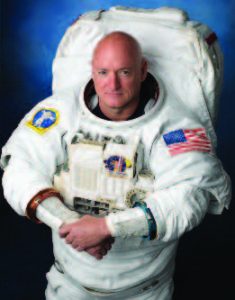
Scott Kelly

Mark Kelly
New Jersey has put the most identical twins in space.
One set is enough for the record here. Mark and Scott Kelly grew up in West Orange. Mark, who is married to Gabby Giffords, is six minutes older. New Jersey also put a man on the moon (Buzz Aldrin, Oradell) and produced the first American woman to walk in space (Kathyrn Sullivan, Paterson).

Courtesy of Dusso Janladde
New Jersey has the world’s tallest roller coaster.
Great Adventure’s Kingda Ka stands 456 feet tall. The ride is basically a dead drop, and is less than 30 seconds long. At a top speed of 128 mph, it’s the second-fastest on the planet. New Jersey can also claim the most insane amusement park ever: Action Park. That was actually the name of a 2013 documentary, which featured the unforgettable Cannonball Loop. If you rode it, you know what I’m talking about.
 GPS COMES TO GREEN BROOK
GPS COMES TO GREEN BROOK
The General Plumbing Supply Team at their new Green Brook Showroom is ready to help customers with all their kitchen, bath and lighting needs. GPS is one of the largest plumbing supply operations in the state, with fourteen locations — nine of which are showrooms — designed to show off the latest trends in kitchen and bath design. GPS works with contractors and homeowners alike, and they partner with all of the best-known brands, from Kohler and Moen to KraftMaid and Grohe. Thanks to Elisabeth Woomer for her help with the story on page 15.
 ALWAYS ROOM FOR ONE MORE AWARD
ALWAYS ROOM FOR ONE MORE AWARD
Trinitas honorees gathered to display their awards at the 97th Meeting of the New Jersey Hospital Association. At center, Gary S. Horan, President and CEO, FACHE, displaying his 2016 Distinguished Service Award, flanked by, from left, Joe McTernan, DHSc, FACHE, Senior Director of Community and Clinical Services; Mary McTigue, VP, Patient Care Services and Chief Nursing Offi-cer, Brant Maslowski, MICP, Mobile ICU Coordinator, holding the Excellence in Quality Improvement Award which recognized Trinitas’ Mobile Integrated Health Service (MIHS) program; Raffi Matossian, MD, Emergency Department; Lucy Ankrah MA, MSN, ANP-BC, Transitional Care Coordinator, and Rod Muench, Director, Pre-Hospital Services, all of whom celebrated both awards.
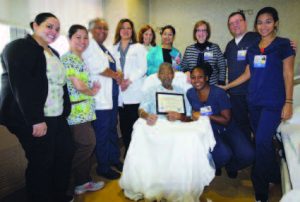 I AM LEGEND
I AM LEGEND
Shade M. Lee, a 94-year-old Elizabeth resident who served in World War II as one of the Tuskegee Airmen, was saluted for his service by receiving a “We Honor Veterans” certificate from the VA and NHPCO program in recognition of his service and sacrifice. The Tuskegee Airmen were the first African-American military aviators in the United States Armed Forces. They served as air fighters and bombers in World War II. Lee trained at Moton Field, the Tuskegee Army Air Field, and was educated at Tuskegee University, in Alabama. Trinitas staff members celebrated his historic place in US military history.
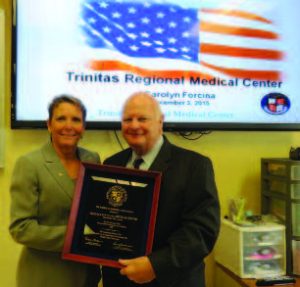 KUDOS FOR COMMITMENT
KUDOS FOR COMMITMENT
Carolyn Forcina, Regional Representative for the American Hospital Association in Washington, DC, presented a plaque to Gary S. Horan, President and CEO, in recognition of the decades of service Trinitas and its predecessor hospitals have offered to the residents of Elizabeth and surrounding communities.
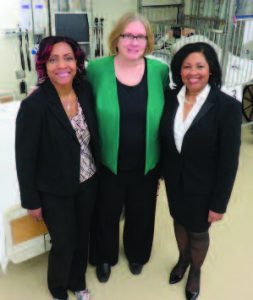 A DEGREE ABOVE
A DEGREE ABOVE
Rutgers University School of Nursing graduate, Dr. Dawn M. Zimmerman,DNP, RNC, APN, CNE, faculty member at the Trinitas School of Nursing (right), is now among the less than 1% of nurses nationwide who hold the Doctor of Nursing Practice degree. She joins Nicole A. Champagne, BS, RN, DNP (left) and Janine Graf-Kirk, DNP, RN-BC, CNE, of the School of Nursing, who hold this prestigious advanced degree.
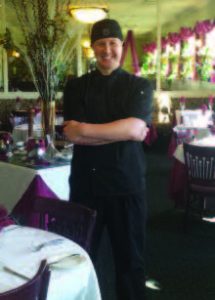 WORD OF MOUTH
WORD OF MOUTH
The Garden Restaurant in Union recently welcomed the acclaimed Justin Massie as its new Executive Chef. Massie, a graduate of the California Culinary Academy of San Francisco, honed his craft in prestigious 5-star kitchens, including the Ritz Carlton Dana Point in Laguna Beach and the Peninsula and SLS Hotels, both in Beverly Hills. He returned to New Jersey to work at the celebrated Heldrich in New Brunswick. “You need to love what you do to be successful in this industry, and I absolutely love what I do,” Massie says. “Even if it’s a classic dish, I look to put my own contemporary twist on it, just to show people something they’ve never seen before. I look to outdo myself on a daily basis, and that’s what gives me the drive to get to the next level with everything I do.
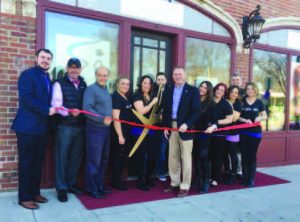 IMAGE IS EVERYTHING
IMAGE IS EVERYTHING
Elegant Image in Westfield held a grand reopening recently at its more spacious quarters on South Avenue West. Owner Claudia Cruz and her husband Jon Regen (center) did the ribbon-cutting honors as Westfield business leaders Jerry Sullivan, Jeffrey Christakos, Gene Jannotti, salon manager AmyLynn Rollins, members of the Elegant Image staff, and Councilman Sam Della Fera, celebrated the relocation. The Westfield salon was previously located on West Broad Street.
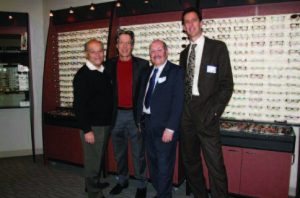
Photo provided by Joe Renna, Photographer
SEEING IS BELIEVING
The Eye Care & Surgery Center hosted the Westfield Chamber of Commerce for an evening of education and engagement. From left to right: Gene Janotti, Greater Westfield Chamber Board Member; Dr. Joel Confino and Dr. Ivan Jacobs, co-founders of Eye Care & Surgery Center, and Dr. Milton Kahn, partner.
Gifts with THE FORCE

R-TOE-D-TOE
You don’t have to be artificially intel-ligent to snag a pair of Star Wars ’Droid Socks. Available at best-wedding-anniversary-gift-ideas.com.

JUST FUR FUN
The Chewbacca Can Cooler keeps beverages cold and fuzzy. Available at thinkgeek.com.

DARK SIDE The Thermos Kylo Ren FUNtainer may make bullies think twice before demanding your kid’s lunch money. Available at toysrus.com.

LUKE WORN?
You can’t know a Jedi without first walking in her footsteps…or Skywalker Light Saber Heels. Available at fun.com.

WAY COOL
The BB-8 Mini Fridge was inspired by the skittish astromech in The Force Awakens. Available at zulily.com.

BIT OF A STRETCH
Thanks to Rebel Alliance Yoga Pants, your downward facing Babbajo never looked so good. Available at thinkgeek.com.
Gifts for the ONE You Love

DOTS BEAUTIFUL Burberry’s whimsical update on its classic Giant Check Scarf—the #1 high-end fashion item at Bloomies over the holidays—is back in stock. Available at bloomingdales.com.

CAMP TIME
Gamers can rest easy with the Xbox One Pillow by Joseph Galbraith. Available at redbubble.com.

SIMPLY AMAZIN’
Old-School Baseball Cards are making a comeback with young collectors. Available at attackofthebbcards.com.

IN THE RED
Cat in the Hat fans will want to un-box the infant/toddler Thing 1 Bodysuit as soon as it’s delivered. Available at aliexpress.com.

FETCHING FASHION
The Barkology
Alpha Dog Cap let’s your dog know who’s #1 (duh, he is, of course). Available at bissf.com.
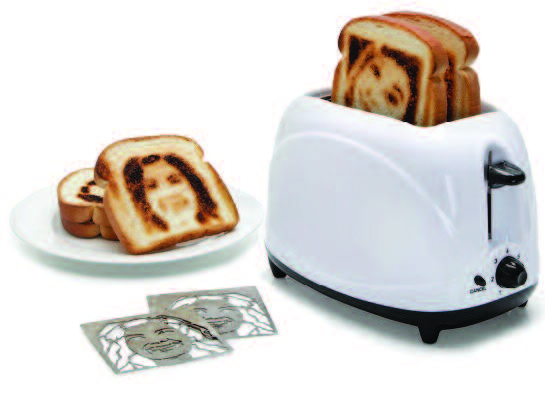
SLICE OF LIFE
Brand your own image into every piece of toast with the Selfie Toaster. Available at hammacher.com.
We welcome the community to our programs that are designed to educate and inform. Programs are subject to change.
SEMINARS
THURSDAY, APRIL 28
6:00 – 7:30 pm
Hypertension:
Keeping it Under Control
Speaker: Dr. Vasyl Pidkaminetskiy Primary Care Physician
Trinitas Physicians Practice
1600 Saint Georges Ave., Suite 111 Rahway, NJ 07065
Call (908) 994-8939 to register.
TUESDAY, MAY 17
5:30 – 7:30 pm
Be Proactive: Protect Your Skin
In recognition of Skin Cancer Awareness Month
Speaker: Carol Blecher, RN, MS, APN Trinitas Comprehensive Cancer Center
CORE Building, 1164 Elizabeth Ave., Elizabeth, NJ
(Enter parking lot from South Broad St., next to Firehouse) Light Dinner will be served.
Call (908) 994-8939 to register.
TCCC SUPPORT GROUPS
Conference Room A or Conference Room B
Trinitas Comprehensive Cancer Center
225 Williamson Street, Elizabeth New Jersey 07207
All events take place from 1pm to 3pm.
Call (908) 994-8535 for 2016 schedule.
Living with Cancer
Viviendo con Cáncer, Grupo De Apoyo
Living with Breast Cancer
Viviendo con Cáncer de Mama
Caregiving Support Group
Viviendo con Cáncer, Grupo De Apoyo
Viviendo con Cáncer, Apoyo Familiar
For more information on any TCCC support programs and to RSVP, please contact Roxanne Ruiz-Adams, LSW, (908) 994-8535. Por favor llame al (908) 994-8535 para confirmar su asistencia.
SPECIAL PROGRAMS
Health Services with Women In Mind
Trinitas helps provide women access to vital health services with a focus on preventive measures. These include educational programs and cancer screenings. Programs offered in English and Spanish.
To learn more about these services, contact Amparo Aguirre, (908) 994-8244 or at amaguirre@trinitas.org
Ask the Pharmacist:
Medication Management
Free of charge, by appointment only.
Monthly on the 4th Tuesday, 11:30 am – 1:00 pm
Call (908) 994-5237
TRINITAS HEALTH FOUNDATION EVENTS
THURSDAY, MAY 12
Gala Dinner Dance
The Venetian, Garfield, NJ
THURSDAY, JUNE 16
8th Annual Andrew H. Campbell Sporting Clays Tournament
Hudson Farm Club, Andover, NJ
MONDAY, SEPTEMBER 12
Annual Golf Classic & Spa Day
Echo Lake Country Club, Westfield, NJ
For more information about the Foundation or to learn more about its fundraising events, (908) 994-8249 or lciraco@trinitas.org.
Proceeds from these and other events benefit the patients of Trinitas Regional Medical Center. Making reservations for Foundation events is fast and easy on your American Express, MasterCard, Visa or Discover card!
For more information, visit
http://www.trinitasrmc.org/foundation.htm
MEDICAL AND BEHAVIORAL HEALTH SUPPORT GROUPS
Diabetes Management Support Group
Monthly, First Monday, 2:00 – 3:00 pm
Kathleen McCarthy, RN, CDE (Certified Diabetes Educator)
Open to both diabetics and non-diabetics who want to learn more about diabetes prevention.
65 Jefferson Street, 2nd Floor, Elizabeth, New Jersey Call (908) 994-5502 for further information or registration
Sleep Disorders
If you or someone you know experiences problems sleeping, consider contacting the Trinitas Comprehensive Sleep Disorders Center in Elizabeth. Another location can be found in Cranford at Homewood Suites by Hilton with easy access on and off the Garden State Parkway. Both centers are headed by a medical director who is board certified in sleep medicine, internal medicine, pulmonary medicine, and intensive care medicine, and is staffed by seven certified sleep technologists.
For further information, call (908) 994-8694 to learn more about the Trinitas Comprehensive Sleep Disorders Center or visit www.njsleepdisorderscenter.org
Narcotics Anonymous
Monday 7:00 – 8:30 pm
Sunday 12:00 noon – 2:00 pm; Sunday 5:00 – 6:30 pm
Jean Grady, Community Liaison, (908) 994-7438 Grassmann Hall, 655 East Jersey St., Elizabeth
Alcoholics Anonymous
Friday 7:30 pm – 8:45 pm
Jean Grady, Community Liaison, (908) 994-7438 Grassmann Hall, 655 East Jersey St., Elizabeth
HIV Education and Support Program
for HIV Positive Patients
Monthly. Call for scheduled dates/times.
Judy Lacinak, (908) 994-7605
Early Intervention Program Clinic, 655 Livingston St. Monastery Building, 2nd Floor, Elizabeth
Mental Illness Support Group (NAMI)
for Spanish Speaking Participants
4th Friday of each month except August, 6:30 pm – 8:30 pm Mike Guglielmino, (908) 994-7275
Martha Silva, NAMI 1-888-803-3413
6 South Conference Room, Williamson Street Campus 225 Williamson Street, Elizabeth
TRINITAS CHILDREN’S THERAPY SERVICES
899 Mountain Avenue, Suite 1A, Springfield, NJ • (973) 218-6394
“10 Tips…” Workshops
The 10 Tips Workshop Series is in its last weeks for the 2015 – 2016 season. The series focuses on in-home or in-classroom activities. All information presented is appropriate for those who interact with children of all ages with an emphasis on preschool and school-aged children. Tips are geared toward home, school, and community environments.
All workshops take place at the Trinitas Children’s Therapy Services Center, 899 Mountain Ave, Suite 1A, Springfield NJ. We look forward to seeing you!
Workshops are $15 each with discounts available for enrollment in multiple sessions.
Tuesday, April 12, 2016 6:00 pm – 7:30 pm
10 Activities to Improve Sensory Processing Skills
at home or in the classroom, Part 1
Tuesday, May 10, 2016 6:00 pm – 7:30 pm
10 Activities to Improve Sensory Processing Skills
at home or in the classroom, Part 2
Saturday, May 14, 2016 9:00 am – 12 noon
Repeat of April and May evening programs
Tuesday, June 14, 2016 6:00 pm – 7:30 pm
10 Activities to Keep Learning during the Summer
at home or in the classroom
For more information or to register for one or more workshops, please contact Christine German, OTD, OTR, at (973) 218-6394, ext. 4012, or email CGerman@trinitas.org
Spring Programs through May 2016
All programs are offered once a week for 45 minutes
at Trinitas Children’s Therapy Services, 899 Mountain Avenue, Suite 1A, Springfield, New Jersey 07081
These programs and/or group therapy sessions are a great alternative to individual therapy. They give children the opportunity to address key developmental areas in structured but busier environments that are more reflective of typical real-life home and school situations.
Cook with Us
Children learn the basics of daily nutrition and fitness as they prepare simple meals and snacks in a practical and fun environment. Overseen by a PT and personal trainer.
Scribbles to Script Handwriting Program
Handwriting for preschoolers through elementary school aged children in a fun atmosphere that uses multi-sensory activitiies to reinforce learning. Uses the Handwriting With-out Tears program. Helps to reinforce learning and make writing fun! Overseen by an OT.
Sports Readiness
An introduction for children into several fall/winter sports, including soccer, basketball, football, and kickball, in a non-competitive group setting. Overseen by a PT.
Social Butterflies
An opportunity for children to engage in activities to address turn taking, topic maintenance, appropriate ques-tion asking, following non-verbal cues, and using manners. Overseen by a speech & language pathologist and/or an OT.
Typing Whizkids
An opportunity for children to learn efficient keyboarding/typing skills, including key location and finger placement, and speed and accuracy. Overseen by an OT.
My Trinitas Movement Groups
3 – 6 months; 6 months -12 months; 18 months – 24 months, 2 – 3 year olds
Children and parents/caregivers will participate in move-ment-based activities to address social interaction, turn-taking, following directions, motor planning, coordination, and motor skills. Sign up for one week or more, up to a full 12 weeks.
Parents Night Out
Drop your child(ren) off for a few hours of fun play time, a movie and a snack, while mom and dad enjoy a much needed night out. Scheduled quarterly. Call for dates.
To register for any programs or for more information, please contact Kevin Nelson at knelson@trinitas.org,(973) 218-6394, ext. 13, or fax (973) 218-6351.
To learn more, visit www.childtherapynj.com
This page is sponsored by
Elizabethtown Healthcare Foundation
Inspired to Care, Inspired to Give
Doctors are catching abdominal aortic aneurysms before they can kill.
By Erik Slagle
Adrian Velasquez was fortunate. During a routine physical in early 2015, doctors discovered a silent killer developing in his abdomen—an aneurysm had formed in the aorta, the largest artery in the body, which runs from the heart and supplies blood to every organ in the body. It was an abdominal aortic aneurysm (AAA), a condition that often goes unnoticed until it ruptures. When that happens, 85 percent of patients do not survive.
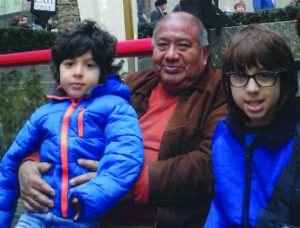 Adrian was doubly fortunate in that his doctors had caught his condition early, and that he would soon come under the care of the Vascular Surgical Team at Trinitas Regional Medical Center. A 78-year-old resident of Roselle Park, Adrian was referred to the team of vascular and endovascular surgeons on faculty at Rutgers-New Jersey Medical School (NJMS).
Adrian was doubly fortunate in that his doctors had caught his condition early, and that he would soon come under the care of the Vascular Surgical Team at Trinitas Regional Medical Center. A 78-year-old resident of Roselle Park, Adrian was referred to the team of vascular and endovascular surgeons on faculty at Rutgers-New Jersey Medical School (NJMS).
Dr. Michael Curi, chief of Vascular Surgery at NJMS and Trinitas, explained he would operate to repair the aneurysm—not through invasive open surgery, but through a minimally invasive endovascular procedure known as a Stent Graft. Dr. Curi enlisted his partner, Dr. Timothy Wu, an expert in percutaneous techniques, so they could perform the entire procedure using just two needle punctures without creating an incision.
“We recruited Dr. Wu to the faculty at Rutgers because of his vast experience with minimally invasive techniques such as these for treating all forms of vascular disease,” Dr. Curi explains, “and so we could also make these advanced techniques available at Trinitas. These techniques are game-changers for patients who would otherwise not do well with the more invasive, traditional therapies for treating AAA.”
“I was very thankful for Dr. Wu’s recommendation and approach,” Adrian says. “Given my age and weight (210 pounds), this was the most appropriate option for me. The fact that it was non-invasive was a great relief to me and my family.”
Surgery to correct these types of aneurysms before they rupture has traditionally been aggressive and invasive, requiring major incisions and an extended hospital stay. Recovery is typically lengthy and uncomfortable. But the endovascular technique has changed that.
“Elective repair, as was performed on Mr. Velasquez, can be greatly beneficial to patients who have this condition,”
Dr. Wu says. “Once an abdominal aortic aneurysm ruptures, the loss of blood is extremely damaging. When one is discovered early, the majority of cases can be treated with stents in a fashion similar to Mr. Velasquez’s. This is preferable, as the open approach to these aneurysms introduces a high level of trauma to a patient’s body. The percutaneous method significantly cuts down on that trauma and greatly eases recovery.”
Adrian’s age, Dr. Wu adds, made him an excellent candidate for the minimally invasive method. Correcting an AAA through endovascular surgery saves up to two hours of anesthesia time for a patient, and hospital stays can be cut from 5 to 7 days down to just 1 or 2. Adrian spent less than two days in the hospital following his December 10th procedure, giving him plenty of time to spend the holidays with his grandchildren.
“I was able to come home to my family much more quickly thanks to Dr. Wu’s method,” he says. “I had very little discomfort…no pain that was out of the ordinary at all.”

www.istockphoto.com
As screenings for abdominal aortic aneurysms become more routine, doctors are confident more of these issues can be caught, monitored, and repaired before they become a serious threat to a patient’s life. The SAAAVE (Screening Abdominal Aortic Aneurysms Very Efficiently) Act of early 2006 encourages screenings, providing as part of Medicare coverage a one-time ultrasound exam for individuals considered to be at risk (males between 65 and 75 who have ever been a smoker) or anyone with a family history of AAA.
“We do believe that the SAAAVE Act has contributed significantly to the number of AAAs that have been found, and operated on, before they can rupture,” Dr. Wu says. “These types of aneurysms are known as ‘silent killers’ in the medical field, because patients often don’t know they have one until they’re in severe pain, or until it bursts. I encourage anyone with certain risk factors, especially those with family members who have had an AAA, to talk to their doctor about screening options.”
Adrian Velasquez agrees.
“I’m happy to talk about what happened to me, because I want other people to know about the risk for abdominal aortic aneurysms,” he says. “People should be aware of the importance of getting checked, and that this non-invasive procedure could be available to them.”
Adrian recalls that when surgery for the AAA needed to be scheduled, he was given the option of having it performed at a hospital in Newark, or at Trinitas in Elizabeth. He picked Trinitas because of its proximity to his Roselle Park home. He says it was a good choice.
“I came away with a very good opinion of Trinitas,” he says. “Everyone there—the doctors, the nurses, the whole staff—were professional and kind to me. If someone needs to have a procedure, and Trinitas Regional Medical Center is an option, I definitely recommend it.”

Michael Curi, MD
Associate Professor and
Chief of Vascular Surgery
Rutgers New Jersey Medical School Attending Physician
Trinitas Regional Medical Center 973.972.9371

Timothy Wu, MD
Assistant Professor
Rutgers New Jersey Medical School Attending Physician
Trinitas Regional Medical Center 973.972.9371
’Tis the Season
Springtime heralds a new season of outdoor activities—hiking, biking, jogging, team sports—and after a long winter you are ready to take them on…or so you think. The musculoskeletal system of the body is a complex network of bones, ligaments, muscles and tendons, and at this time of year we see an uptick in sprains, strains and fractures in the Emergency Department.
How many bones are in the human body?
We are born with 270 bones. As adults, we have 206 because some of those bones fuse as the body matures.
What’s the difference between ligaments and tendons?
Ligaments are fibrous tissue that connect bone to bone. Tendons are fibrous tissue that connect muscles to bone.
A joint is defined as two or more bones that join together to create motion.
Are sprained ankles the most common sports injury you see?
Yes. A sprain refers to ligamentous injury. Athletes and weekend warriors often turn the ankle over while running, jumping or pivoting on the ankle joint. Typically, the patient will hear a “pop” or report a tearing sensation. The ankle will swell and walking becomes painful. As clinicians, we are taught several degrees of sprains—first, second and third. The degree of sprain can lead to very important patient discharge instructions. If a patient has a third-degree tear of the ankle ligament, the recovery period is significantly longer.
Why do ligament injuries often take longer than broken bones to heal?
There are several reasons for this. Ligaments that are completely torn lead to joint instability. Ligaments have poor blood supply, which leads to a protracted recovery. Also, the articulating bones are left to move freely and unrestricted. This can lead to the non-union of bones, which—left unrecognized—can progress to chronic pain, swelling and arthritis.
Thankfully, most sprains are first- and second- degree injuries. They heal well with PRICE therapy: Protection, Rest, Ice, Compression and Elevation. Sprains that do not improve over a one- to two-week timeframe may require a repeat evaluation by a physician.
Are these types of injuries less serious in children than adults?
No. On the contrary, children are not “little adults.” A limping child, no matter the circumstance, needs to be evaluated by a medical professional. Also, swelling over a joint, as well as persistent pain and swelling over a bone, requires a medical evaluation. In addition, persistent back pain in a child or an adolescent necessitates a medical evaluation.
How do strains differ from sprains?
A strain refers to an injury to the muscle-tendon complex. Strains are commonly seen in patients who have overstressed muscle groups or who have tried to generate excessive force in a non-conditioned muscle. The generation of tremendous contraction forces coupled with excessive forcible stretching results in a severe strain. Patients typically present a day or two after the injury, because of increasing pain and spasm. The majority of back pain will resolve on its own with rest, analgesia and time. After approximately two weeks, 50 percent of back strains resolve and nearly 80 percent resolve after about six weeks.
What’s the best way to avoid sprains and strains when I begin my springtime outdoor activities?
Proper stretching and mobility exercises are the key to an injury-free spring and summer. Shedding winter weight is another way to assure healthy activity. A five- to ten-pound weight gain can place undue stress on the back and joints.
Can I treat minor injuries effectively myself?
Yes. If you do find yourself injured after a day on the golf course or in the yard with the kids, there are some home remedies that might speed your recovery, including ice and heat. Ice works very effectively as a natural anti-inflammatory and a pain reliever. About 20 minutes every hour for the first three days is prudent. Heat is for muscles, chronic pain and stress. Heat relaxes muscles that are in spasm and calms trigger points of pain. Some more advanced sports medicine clinicians recommend a combination of both hot and cold therapy, which can act like a therapeutic stretch. The cold contracts the tissue and the heat relaxes the tissue. In either case, don’t forget to protect your skin with some kind of barrier to avoid scalding or frost injuries.
What about “getting back on the horse” after a day or two of rest?
Joints are designed to stay in motion. If you injure a knee, ankle, back, shoulder or wrist, you want to avoid prolonged immobilization. Our bodies are meant to stay in motion—the longer we restrict our mobility the longer our recovery may be. However, aggressive early immobilization is smart. Then, if you can move the joint after a day or so of immobilization, introduce the joint to its original fluidity, but reduce its workload. Be very cautious. Slow and steady wins the race. Listen to your body as it permits you to heal. Over-ambitious weekend warriors often find themselves reinjured when they don’t exercise patience with an injury.
When does a back strain warrant a trip to the ER?
In general, if you can’t explain the mechanism that led to the back pain, then an evaluation is warranted. Also, certain historical symptoms and signs would demand an urgent Emergency Department visit, including:
- Sudden onset of back pain without a coinciding mechanism
- Sudden loss of urine or inability to control bowel or bladder
- Fever or chills associated with back pain
- Abdominal pain accompanying back pain
- Age greater than 65 years of age
- Weakness in an extremity
- Intravenous drug users
- Blood in the urine
- Mid-line back pain
- A cancer patient
- COPD patients
How can I tell if my child has a growth plate injury?
These injuries can be insidious. When a child or adolescent presents to the Emergency Department with tenderness and swelling over a joint, we assume there might be a growth plate injury. Growth plate fractures occur in areas where the ligaments are stronger than the developing bone. Most growth plates are closed between the ages of 12 to 16 years old. If a fracture is seen in an x-ray, we can formulate a treatment plan. But sometimes these injuries are occult fractures, which aren’t detected by x-rays until much later. This is referred to as a Salter Harris Type1 injury. The clinician will explain to the parent or guardian that we do not see a fracture, but we cannot completely rule out a growth plate injury, so a reexamination is scheduled in 7 to 10 days. X-rays taken at that point may show no change, which suggest a sprain, or reveal a growth plate fracture. The growth plate attempts to lay down new bone to heal, which appears as a scar or increased density within the growth plate—which wasn’t there on the initial x-ray. A growth plate fracture requires four to six additional weeks of immobilization.
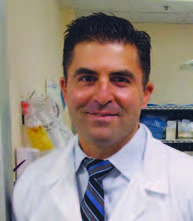
John D’Angelo, DO Chairman/Emergency Medicine Trinitas Regional Medical Center
Editor’s Note: John D’Angelo, DO, is the Chairman of Emergency Medicine at Trinitas Regional Medical Center. He has been instrumental in introducing key emergency medical protocols at Trinitas, including the life-saving Code STemi, which significantly reduces the amount of time it takes for cardiac patients to move from the emergency setting to the cardiac catheterization lab for treatment.
Lou Gossett may not be executing roundhouse kicks anymore, but his power within the motion picture industry has hardly diminished. During the most recent Academy Awards, the camera found him again and again. Gossett, you may recall, was the first African American actor to take home a Best Supporting Oscar (for An Officer and a Gentleman). He also happens to be an influential member of the Academy of Motion Picture Arts and Sciences, as well as a hallowed figure in the greater Hollywood community, which recently endured some high-profile criticism for its lack of diversity. As Editor at Large Tracey Smith discovered, Louis Gossett, Jr. is all about diversity. In fact, it has a lot to do with his unique ability to portray forceful, independent characters who command a story or a scene…and then slowly, grudgingly reveal their vulnerabilities.
EDGE: Are you drawn to forceful roles because they are written this way, or is it a dimension you like to bring to your characters?
LG: I’m not sure. Some of them now are, of course, designed that way for me. I could always play a variety of strong characters. I’d shave my head and play anything I wanted! But I also played Anwar Sadat, which was astounding, and I did Enemy Mine, which was a cult film. So the choices of parts were actually quite diverse.

Photo by David Walden
EDGE: Where do you think that comes from?
LG: It came out of Coney Island—it came out of my childhood [laughs]. I was taught as a child how to live successfully with others, especially those that differ.
EDGE: What was your Brooklyn neighborhood like?
LG: It was a diverse camaraderie coming out of the mud of the Great Depression. I was not born in a “black” neighborhood. I was born into a “society” that was happening after the resurrection of mankind following the Depression. There was a lot of stuff occurring, including a fear that the Communists were taking over—which they were not. But as a result, the intellectual cream of the crop was being run out of higher education. Dr. William Jansen, the New York City Schools Chancellor, moved them all out to the “boondocks” of Brooklyn, where they started an incredible renaissance of learning and art. I had the benefit of a Latin teacher in third grade! My classmates were the children of doctors, dentists, lawyers and schoolteachers. I had my heroes: I saw Jackie Robinson become a Dodger, Ralph Bunche at the United Nations, Walter White and the NAACP. Other kids had theirs—Superman, Hopalong Cassidy. But during my childhood we had no thought of separation because of race. If I didn’t eat dinner at home, I might go to my next-door neighbor’s, where gefilte fish was on the table. Or down the block for corned beef and cabbage. And long before there were cell phones, there were old ladies in the windows making sure the neighborhood was straight.
EDGE: So that experience prepared you to become an actor, to slip inside a character? Is that how you won your first role, in Take a Giant Step?
LG: Yes. I was 17 and had never seen a Broadway play. One day, my English teacher, who read the trades, said, “Hey, Louie. I know you’ve never acted before, but I like the way you read the stuff in class. They’re looking for a kid about your age to play a lead in a Broadway show. Tell your mother to bring you down.”
EDGE: You were very active on the stage during the 1950s and 1960s. But movie and television roles must have been harder to come by. What were some of the challenges you faced in Hollywood and, also, how did you involve yourself in the civil rights effort as you became more well known?
LG: There was something wrong to me about marching for peace, so I did it by personal example—through the roles that I chose, and triumphs in the theater and movies. I hoped it would impress upon people that there was no such thing as “impossible” for the young. In terms of challenges, yes I was challenged a great deal. I was told by the casting people—either verbally or subtly—“I don’t care how many awards you win, you’re still black, you still have to prove yourself.” The limitations I came up against forced me to be as good as I could possibly be.
EDGE: What was your professional life like at that time?
LG: I got a guitar and played folk music for a while in between jobs, and I survived through television. Television was very good to me. I lived well in Malibu, down the street from Michael Landon. Sometimes a guest role was a one- and-done because of the difficulty due to discrimination. But I was able to make some alliances. My first TV movie was Companions in Nightmare, in 1968. Melvyn Douglas played a psychiatrist with a murderer in his group therapy. The cast included Gig Young, who won the Emmy, Ann Baxter, William Redfield, Leslie Nielsen, Patrick O’Neil, and me. These were great actors who came from New York, from Broadway. And they were wonderful to me. I wouldn’t be sitting here if it weren’t for them.
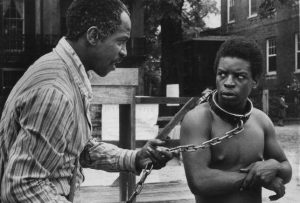
ABC Television
EDGE: In 1977, you won an Emmy for your role in Roots. What happened to your professional life after that?
LG: It exploded! I didn’t know that everybody would stop what they were doing to watch the series. That was a pleasant surprise. I was working a great deal already, though. Around that time, I did an episode of Little House on the Prairie, I did The Rockford Files with Jimmy Garner, and an ABC Movie of the Week. And a wonderful renaissance was happening in television in the 1970s with all that came out of Norman Lear’s consciousness, like All In the Family, The Jeffersons, and Good Times, as well as later shows, like Benson.
EDGE: How did you prepare for an intense, emotional role like Fiddler in Roots?
LG: I did very little preparation.
EDGE: Why?
LG: Because it was in my roots. Fiddler was like my grandparents. Roots was actually very emotional on all of our parts. My best friend at the time was Vic Morrow, who played the guy in charge of the slaves. There was a scene where he ordered a beating to make LeVar Burton’s character say that his name isn’t Kunta Kinte anymore, its Toby. Vic came up to me in advance and apologized. “Lou, I have to do this scene fully.” He did it so fully that I was transformed into saying, “Kunta Kinte—that’s what your name is. That’s what you’ll always be. There’s going to be another day, you hear me?” And we are in another day. Alex Haley told that story quite frequently.
EDGE: You’re perhaps best known for your Oscar-winning role in An Officer and a Gentleman. What are the “hard-to-find” Lou Gossett performances that are not as well known?
LG: A number of television movies. There’s Goodbye Miss Fourth of July, Lawman without a Gun, Carolina Skeletons, and two pilots that I did, To Dance with Olivia, and The Color of Love: Jacey’s Story.
EDGE: You mentioned Enemy Mine earlier, in which you played an alien. That was an interesting choice for a number of reasons. Did the fact you would be physically unrecognizable make the role more appealing or less appealing?

Kings Road Entertainment/SLM Production Group
LG: Everybody turned that role down! You couldn’t see the actor’s face or the eyes. It was a challenge, an artistic challenge, to be able to make a performance credible without the natural use of your eyes, face or body—on top of the five or six hours of make-up. Plus, we had to create a species from scratch, with a philosophy and a language that doesn’t exist, and then get into the hearts and minds of an audience. It was a tough artistic stretch, but a great, great story.
EDGE: Have you always enjoyed testing yourself?
LG: Oh yeah! You’ve got to raise the artistic bar!
EDGE: What do you like about it?
LG: That you never lose your concentration. That’s what’s incredible—you’ve got to keep on trying, you’ve got to dig it out, and deal with all the stuff that gets in your way. The instrument for the actor is himself, his body, his thinking, his emotions, his physical stuff, spiritual stuff. He’s got to be prepared to develop any character without any personal crutches.
EDGE: Our readers were big Boardwalk Empire fans. You had a memorable part in Season 4 as Oscar Boneau, a mentor, if you will, to Michael K. Williams’s character, Chalky White.
LG: It was a great opportunity to play that character because Oscar was Grandpa. A grandfather is in a position of mentorship, what I call selfless service. All the sun comes out when you do that, regardless of whatever you’ve gone through in your life. After that episode aired, people came out of the woodwork, especially young actors. They liked it a lot. It was never nominated or anything like that. But I don’t go for the nominations. I go for what gets the message across.
EDGE: Speaking of nominations and awards, did you get a lot of questions about the Academy Awards this year?
LG: Yeah. But let’s back it up against the bigger picture. Once you’re in the Academy you’re not a black person in the Academy. You’re a member. Black movies, Jewish movies, gay movies, white movies, it does not matter; we are one bunch of people there. The best thing about our organization is that, when they know they’ve made a mistake, they overcompensate and never make it again.
EDGE: In the midst of the current discussion, does your golden statue mean more to you, less to you…?
LG: It’s a reminder—a reminder that you can go as far as you can imagine yourself going, if you prepare yourself properly. For kids, that message is simple: If you shoot for a ten and you get a five, you have five more than you started out with.
EDGE: What else have you learned on this remarkable journey?
LG: Longevity has been a good teacher. I believe that if there is fear, there is no faith, especially when times are hard. I wrote a short poem on this subject:
Things will happen as they will.
The world will never be stronger than faith
Although some of our wildest doubt may sometimes bother our dreams.
Love when it comes, it never comes too late.
I want to be a humble, teachable, moldable part of society and to get myself in a receptive position—spiritually, emotionally, physically—because God wants me to know myself and to conduct myself accordingly, one day at a time. To young people, I say be responsible for yourself and then you will become ambassadors of peace, and miracles can happen.
EDGE: Paul Robeson once said, “As an artist I come to sing, but as a citizen I will always speak for peace, and no one can silence me in this.” What do those words mean to you?
LG: Back in the old days, if you had been a minority and said this, you would’ve been branded a rebe
l. Today, you’re a responsible citizen. The sooner we get to that one people, one nation, one world, one consciousness, the better we’re going to be. We’re not there yet…but thank God we’re going in the right direction.
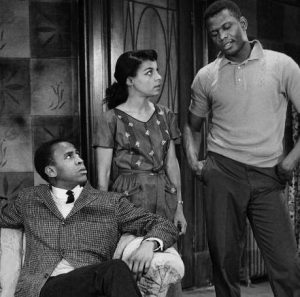
A Raisin In the Sun/Belasco Theatre
THE GOSSETT FILE
Louis Cameron Gossett, Jr.
Born: May 27, 1936 (Brooklyn, NY)
First Broadway Play: Take a Giant Step (1953)
First TV Appearance: The Big Story (1958)
First Hollywood Film: A Raisin In the Sun (1961) Outstanding Lead Actor Emmy: Roots (1977)
Best Supporting Oscar: An Officer and a Gentleman (1982)
Best Supporting Golden Globe: An Officer and a Gentleman (1982)
Best Supporting Golden Globe: The Josephine Baker Story (1991)
Primetime Emmy Nominations: 7

David Walden
Can You Hum a Few Bars?
During the 1960s, Lou co-wrote the popular war protest song “Handsome Johnny” with Richie Havens.
Did You Know?
Lou’s nephew, Robert Gossett, co-stars with Kyra Sedgwick and J.K. Simmons on the TNT series The Closer.
Eracism
Gossett is the founder, president and chairman of the Eracism Foundation. Its mission is to contribute to the creation of a society where racism does not exist. He defines Eracism as the removal from existence of the belief that one race, one culture, one people is superior to another. For more information or to get involved, log onto eracismfoundation.org.
2016 PGA Championship Director
How would you say the PGA Championship compares to other major sports championships?
It’s similar in that we have the best athletes in the world at their chosen profession who will be competing at the highest level of the sport. At the same time, it’s different in that the host venue is a tremendously important part of the story. Championships in all other sports take place on a field of play that is regulated. The Lower Course at Baltusrol Golf Club is unique among the world’s golf courses in its design, layout, and history.
How so?
The Lower Course at Baltusrol is a spectator course. While the scale is epic, the classic design makes it easy to traverse from the back 9 to the front 9. There are excellent vantage points throughout, and the golf course will present the players with numerous strategic options and opportunities to thrill us with their incredible talents. The beauty of the grounds is a joy to experience as the majestic trees will afford ample shade and opportunities to relax and soak in the unique atmosphere. And finally, Baltusrol is one of only four golf clubs in America to be designated as a National Historic Landmark
Do most fans buy tickets for one day or do they go for a package?
Attending on multiple days is by far the best way to experience the Championship. There is just too much to see and experience to fit into one day.
What are some of the interesting things that happen in the days prior to the first round?
The players are more relaxed and will try to execute multiple shots on every hole. This provides a unique opportunity to take pictures, ask for autographs, and get a feel for the best places to watch once the competition begins on Thursday.
What’s the optimal strategy, to follow a specific golfer or to stake out territory at a particular hole so you can see all the players come through?
I prefer to do a little of both over multiple days. There is nothing like following a player for an entire round and getting a feel for how they are playing that particular day. If they are at the top of their game, you can actually feel it—you can see it in their demeanor and in their eyes, and the player starts to feed off of the crowd’s energy. On another day, it is great to find a grandstand with a concession stand and restroom close by, so that you can watch all of the players come through.
How many volunteers will be working the tournament and where do they come from?
We have almost 3,500 volunteers, including residents from 37 U.S. states and six countries outside of the U.S. Almost 2,000 are from New Jersey, but we also have volunteers coming from Finland and even as far as Australia.
What differences will fans who attended the Championship here in 2005 notice in 2016?
There are new parking and transportation options. The merchandise tent on site will be larger and, frankly, worth coming to see all on its own. We have better grandstand options than before and there will be more concession stands with a wide variety of options to choose from. Children 17 and younger now have complimentary grounds access all seven days as long as they are accompanied by a ticketed adult, and we have complimentary Wi-Fi zones on the property.
Log onto pga.com/pgachampionship for more info.

